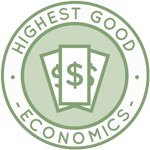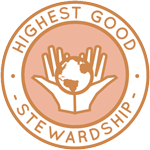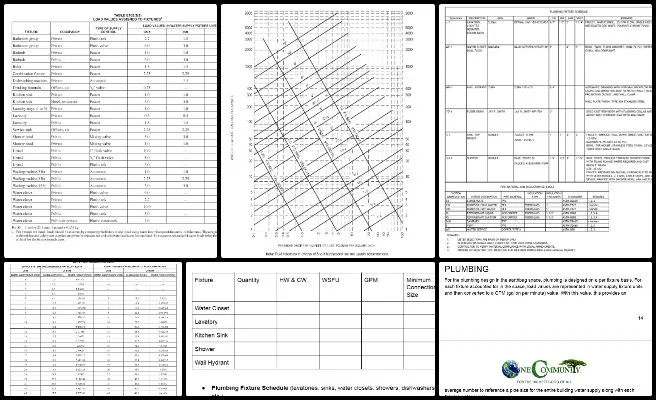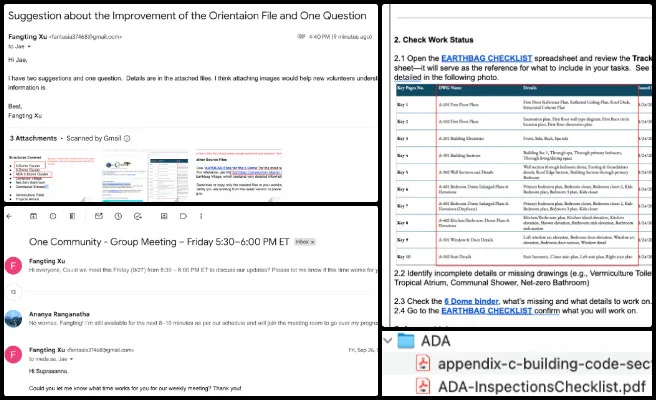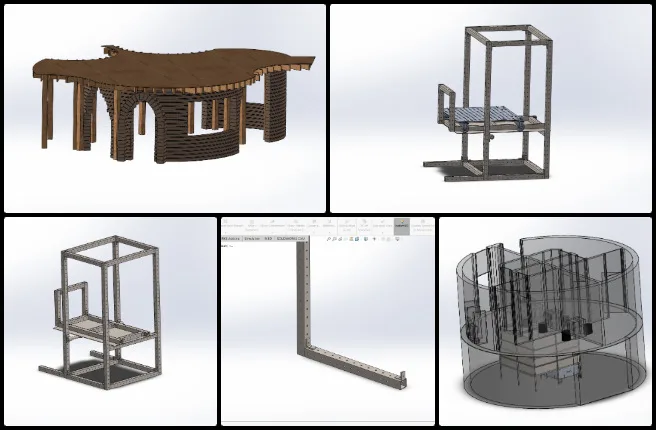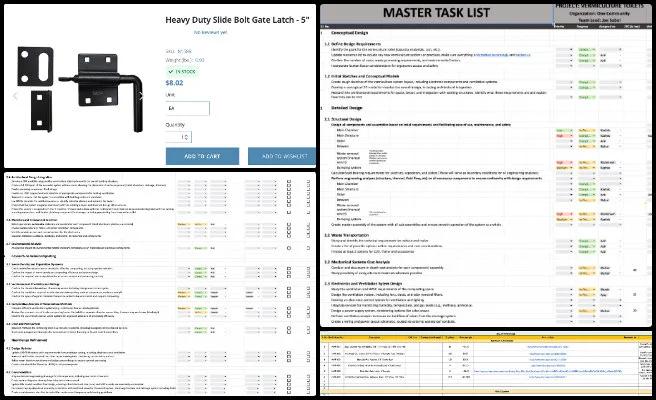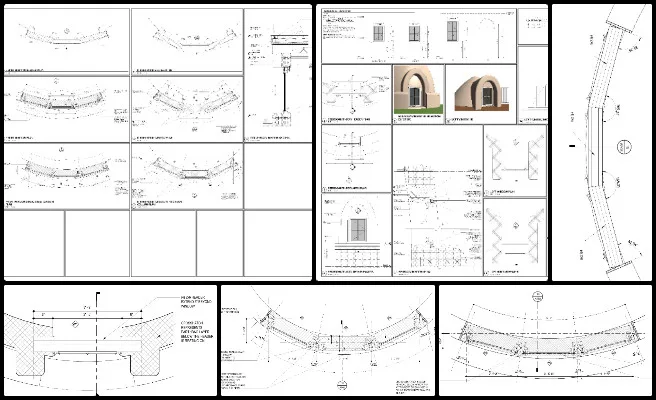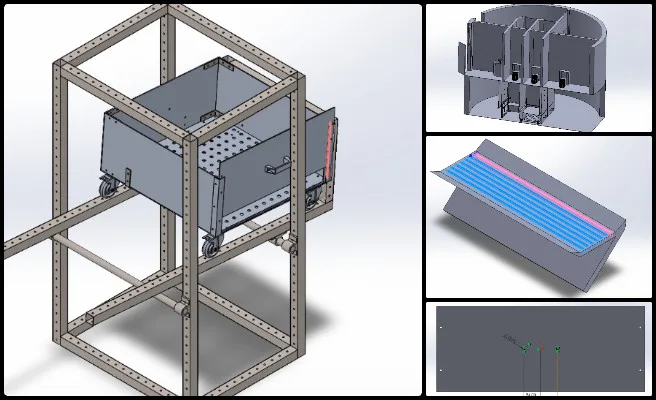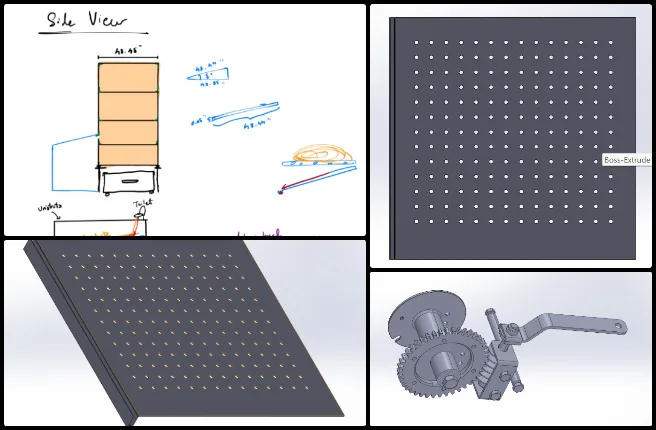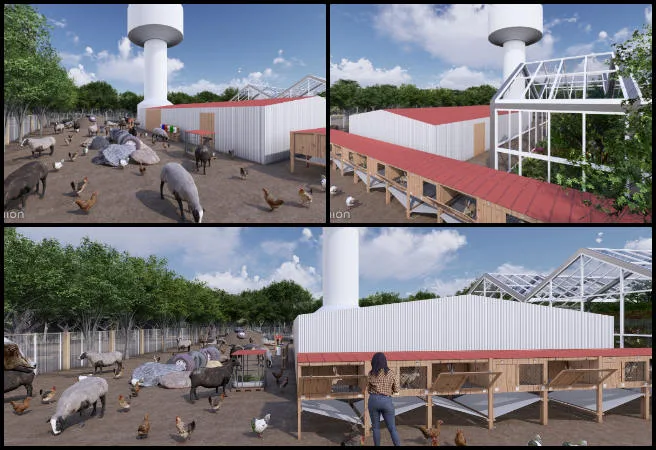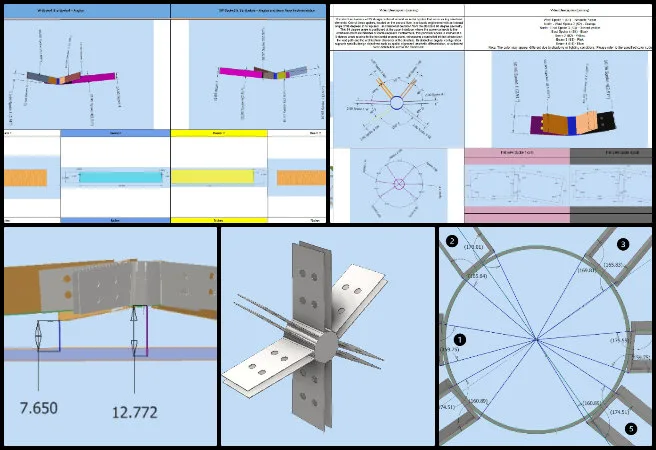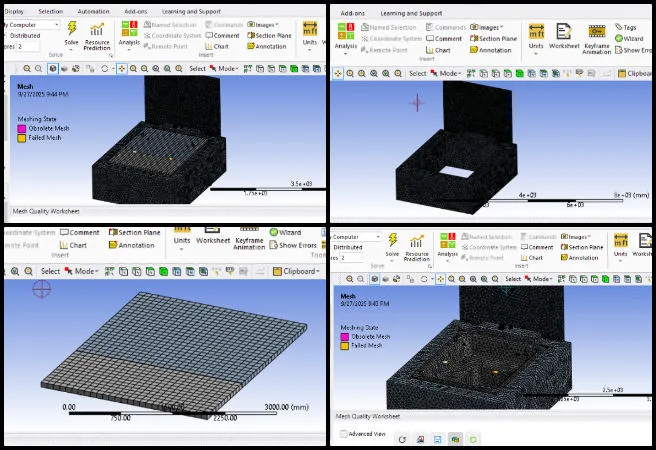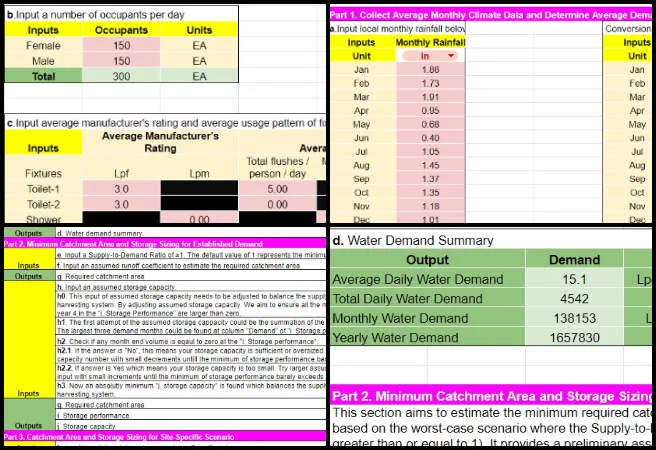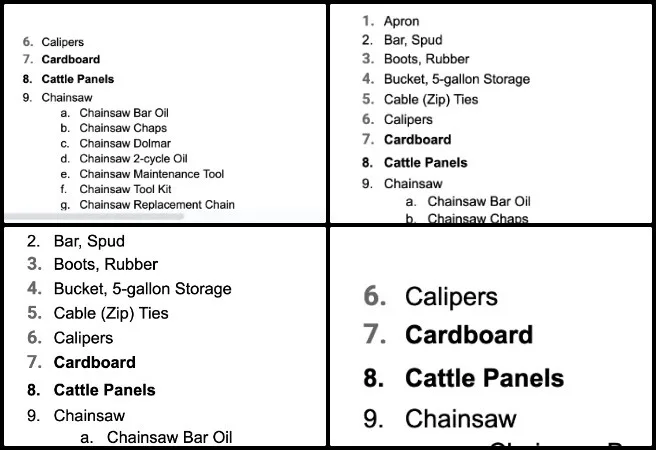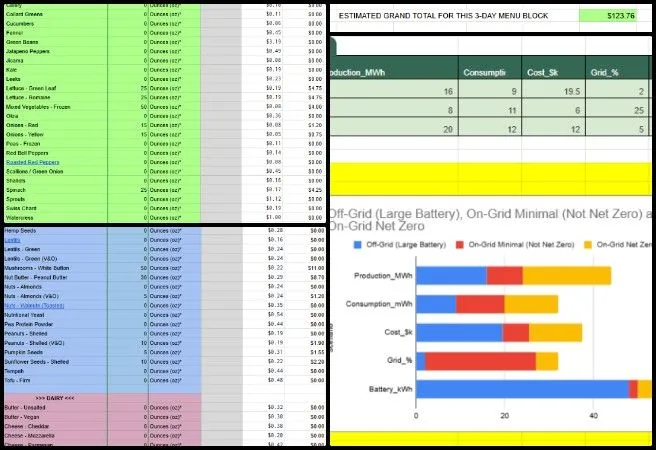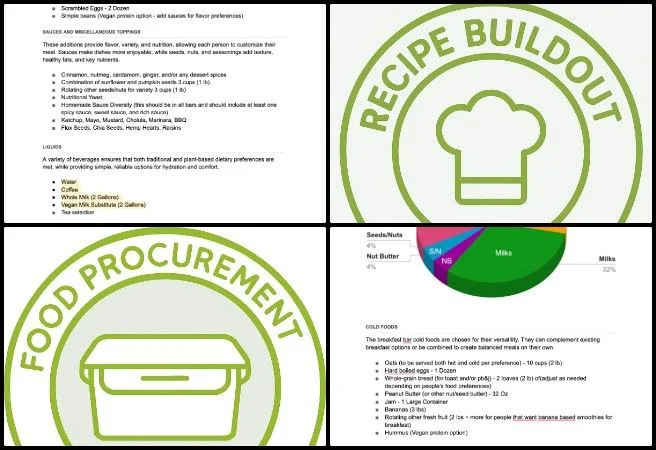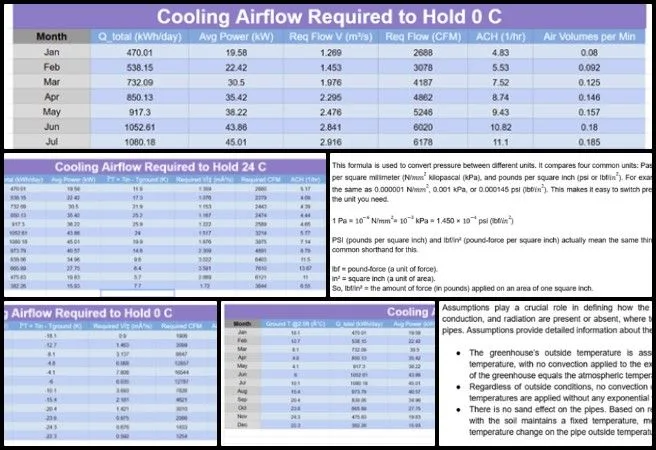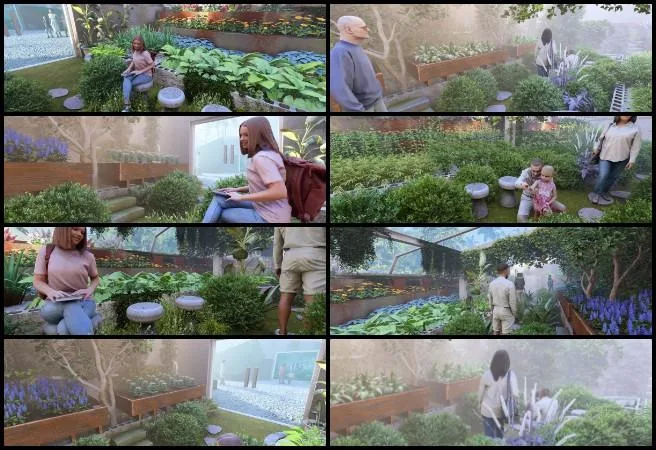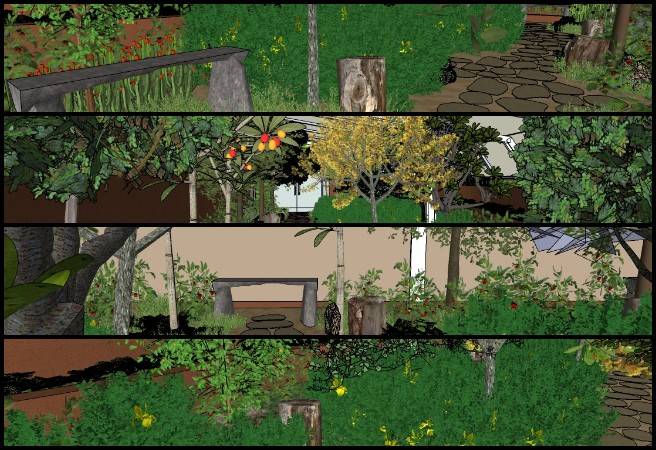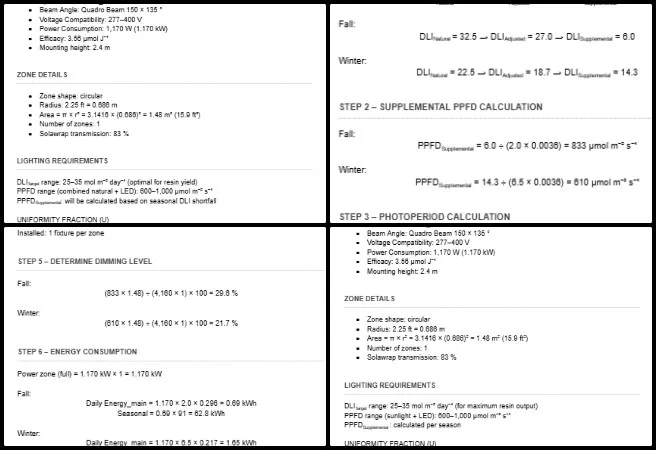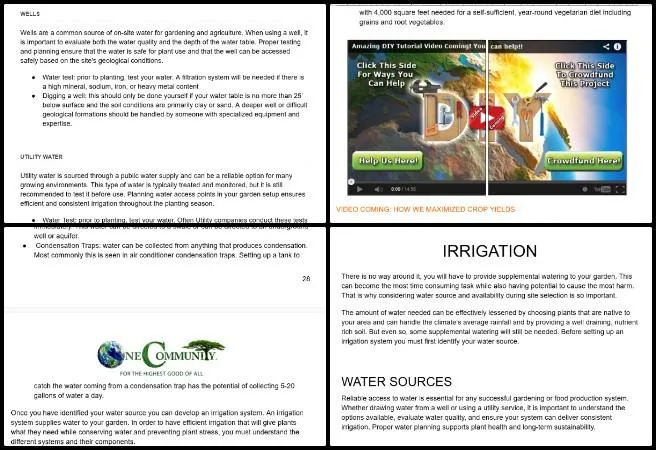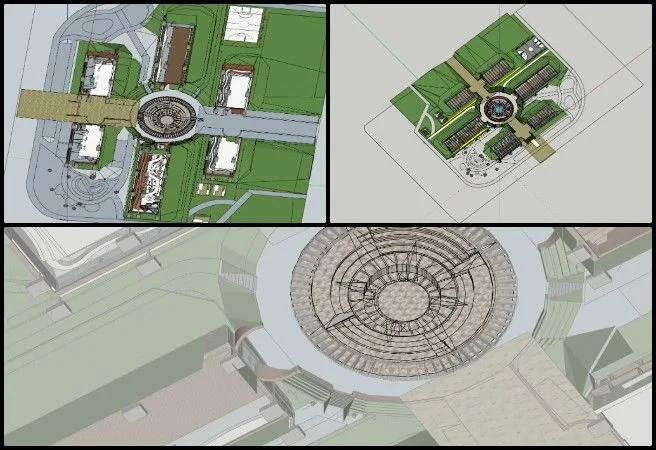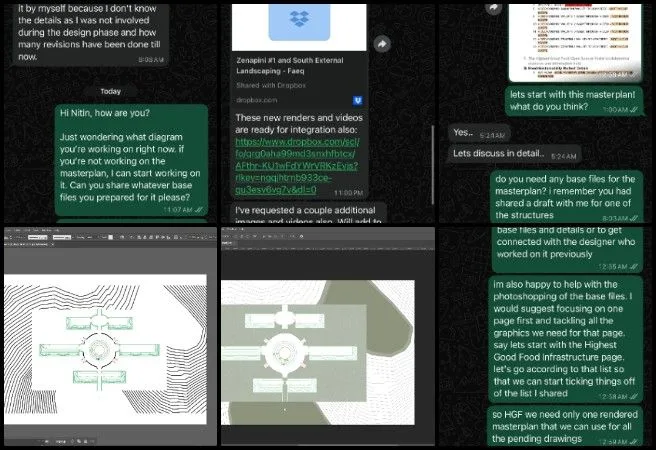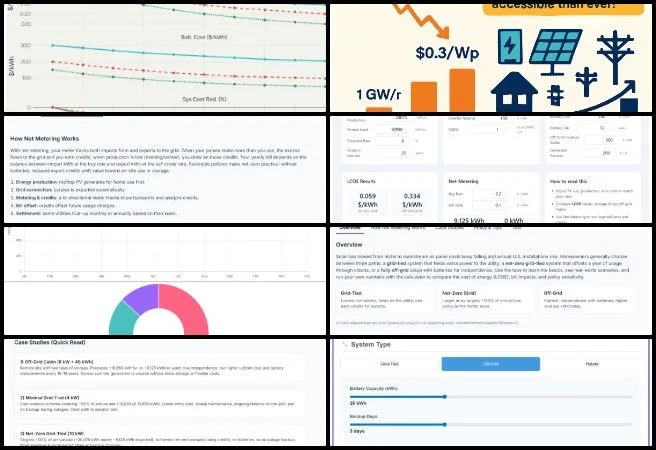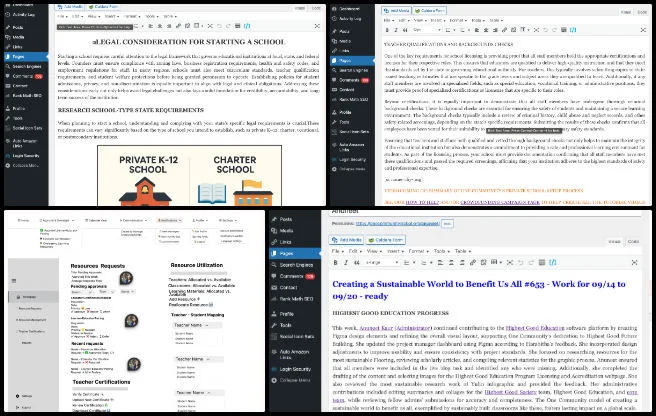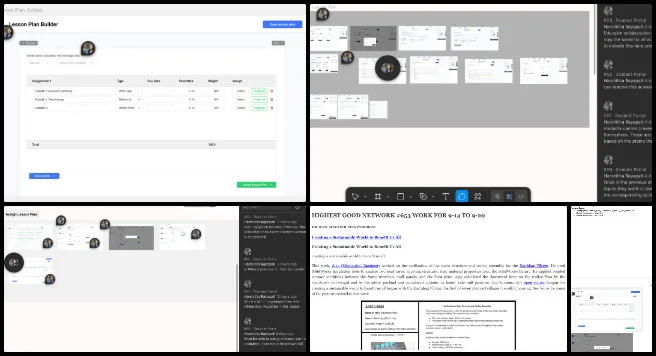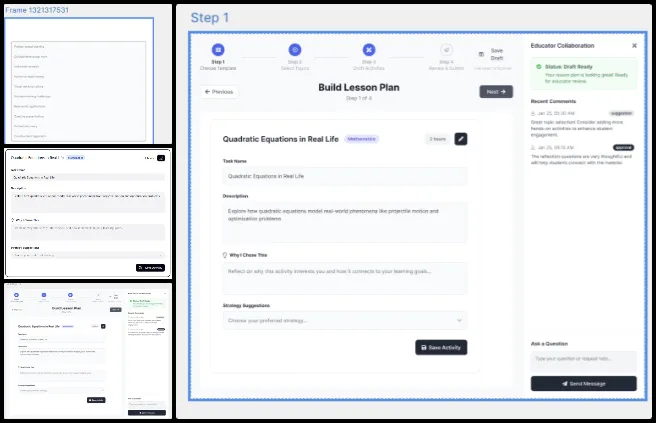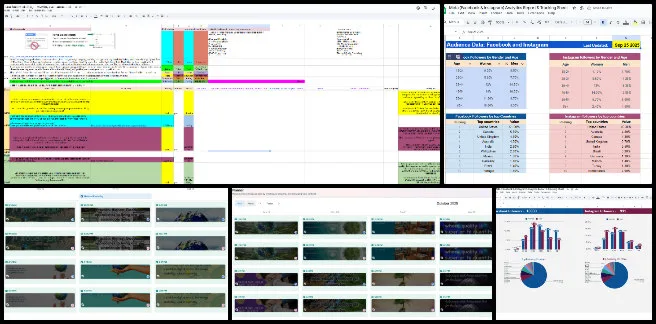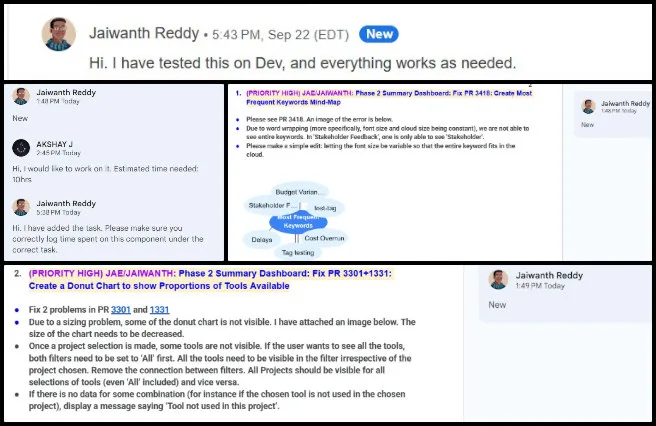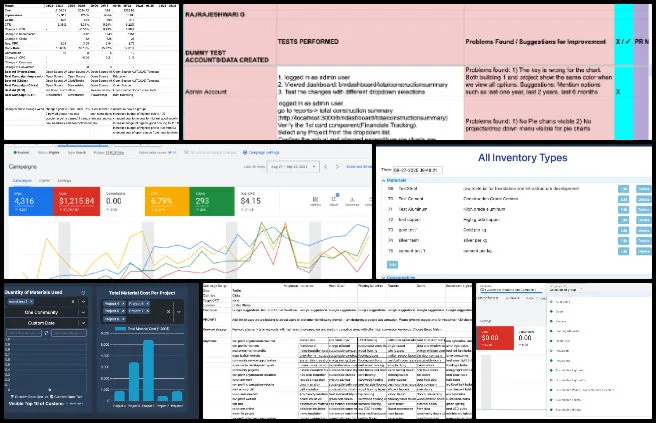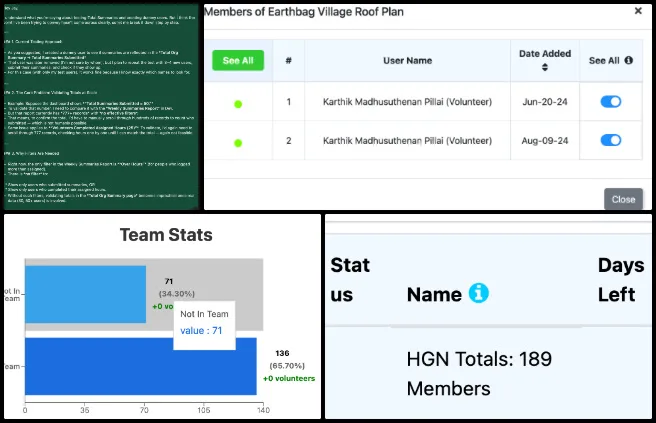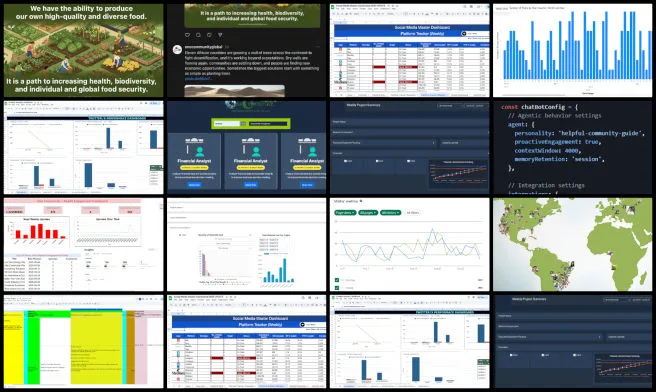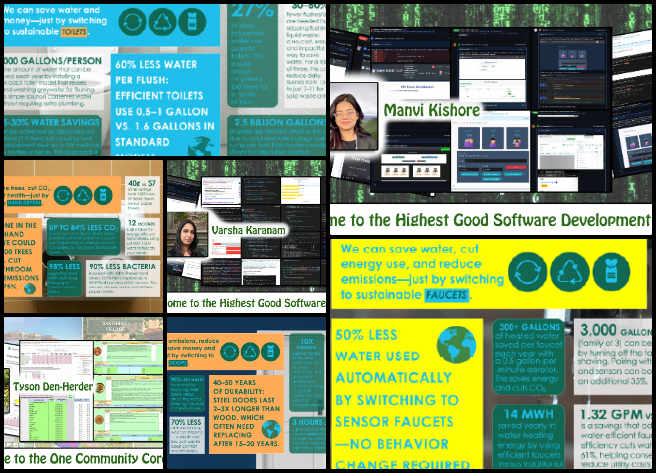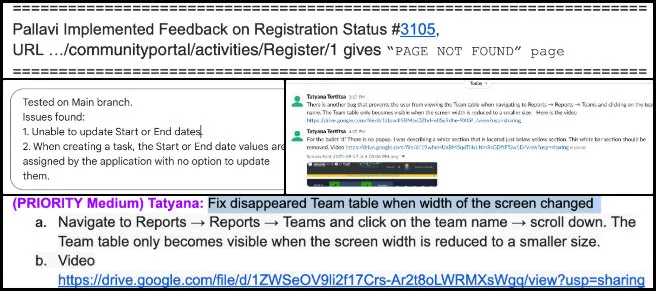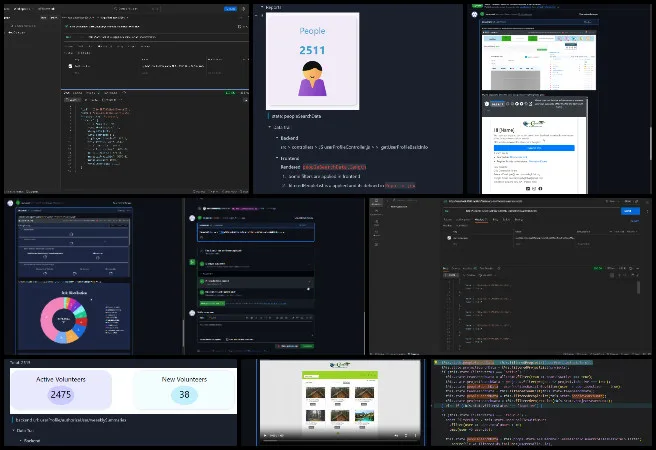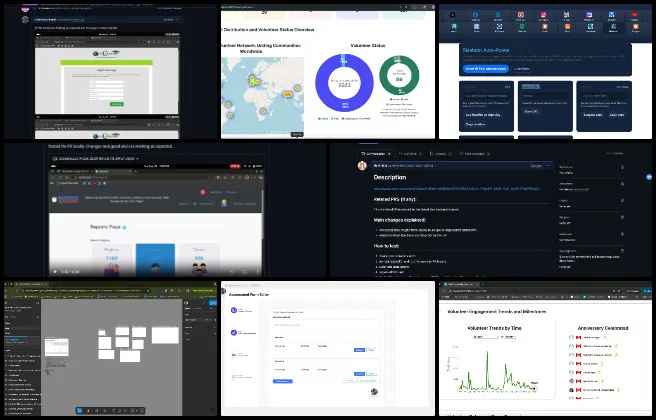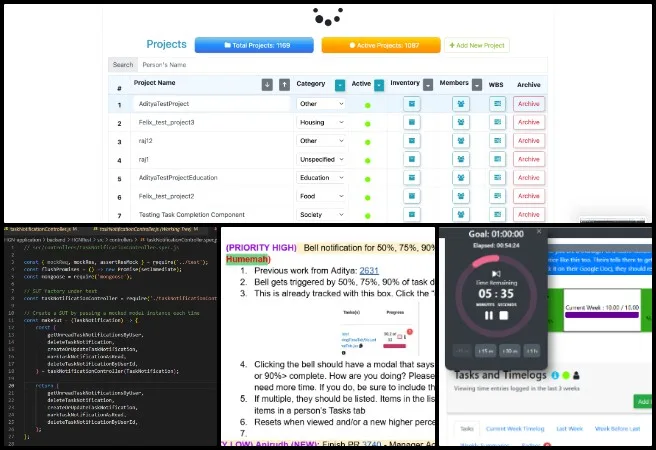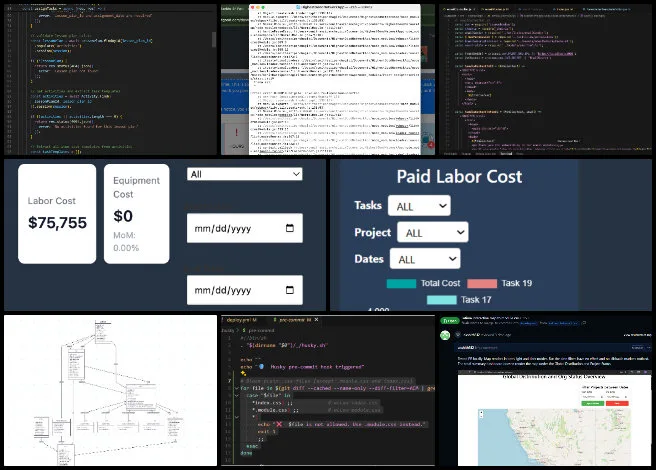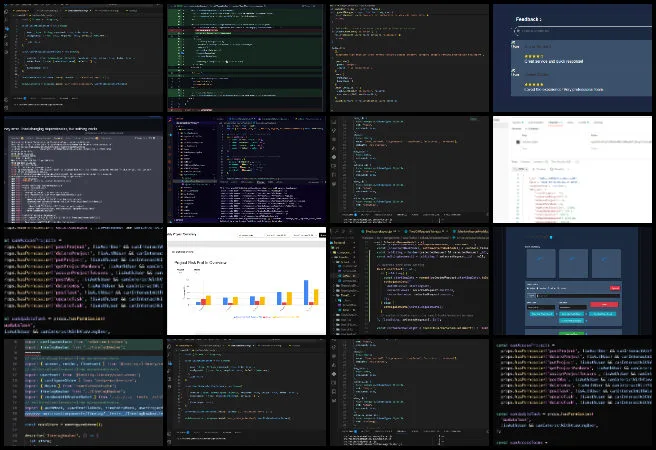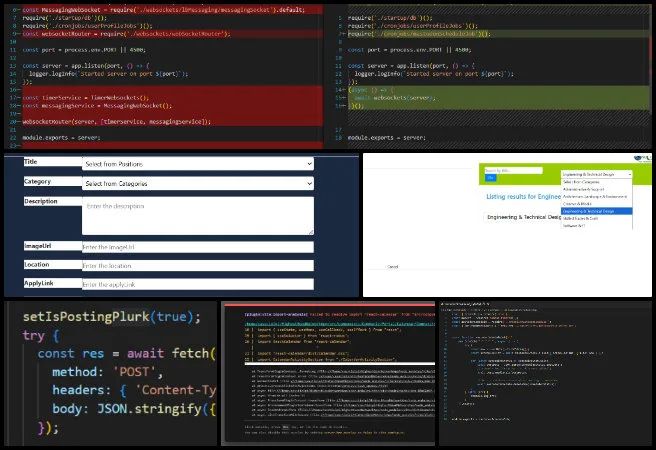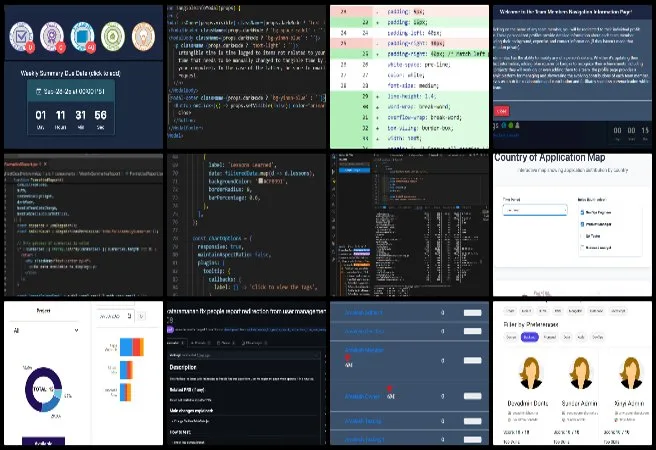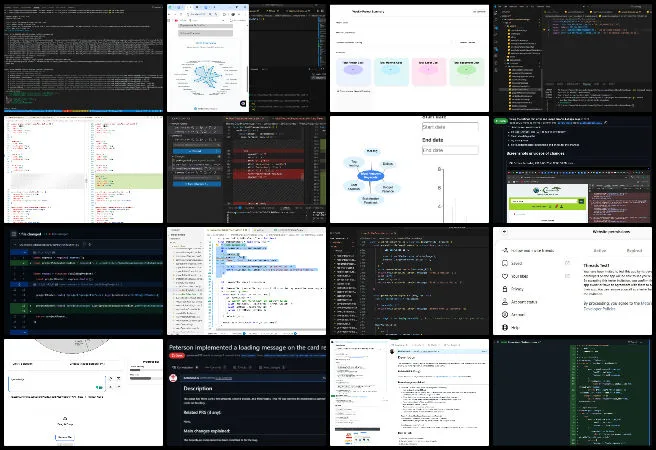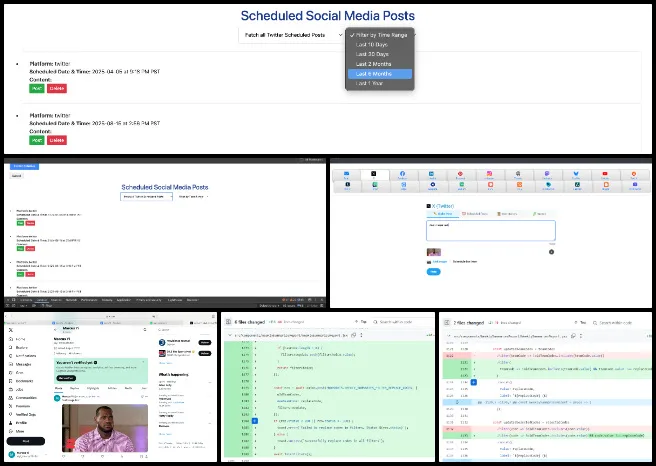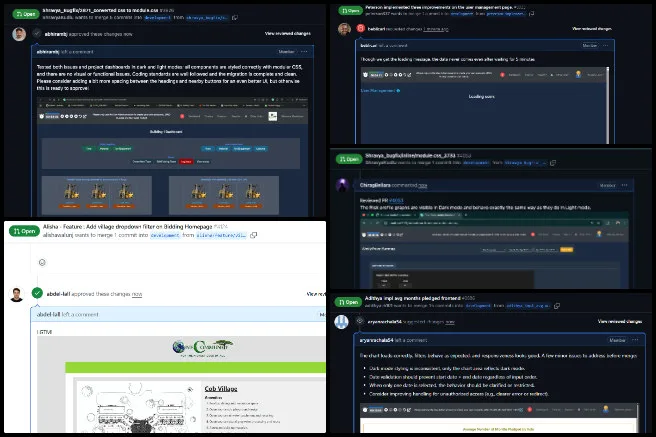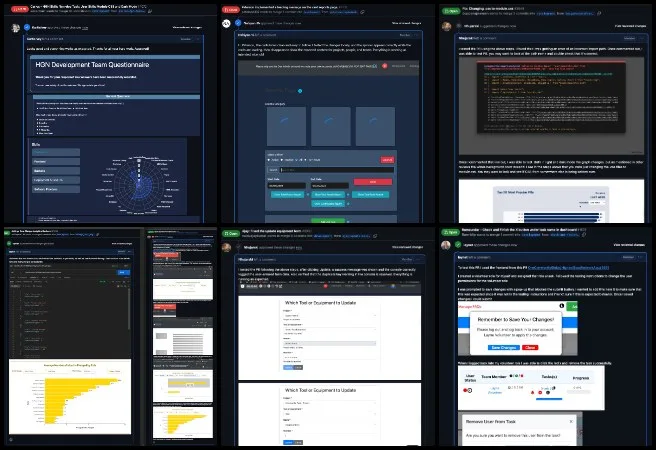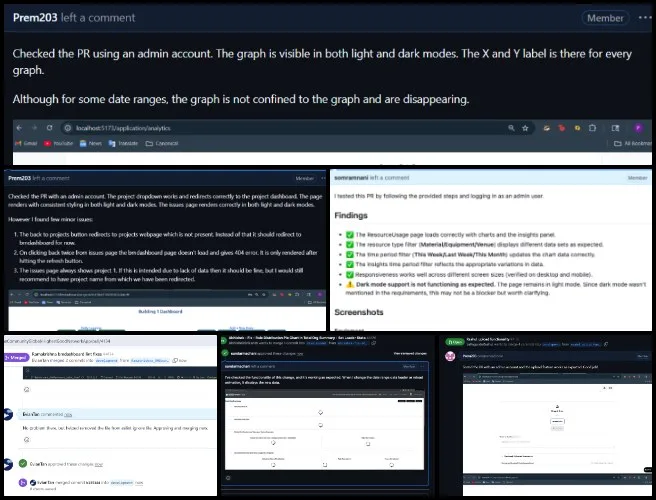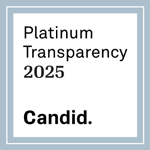Open Sourcing the World We Want – One Community Weekly Progress Update #654
At One Community, we are open sourcing the world we want by designing and freely sharing sustainable approaches to food, energy, housing, education, economics, social architecture, and more as a foundation for global stewardship and fulfilled living. Built entirely by an all-volunteer team, our freely shared model is intended to be self-replicating, supporting a global collaboration of teacher/demonstration hubs. By open sourcing and free sharing the complete process, we are evolving sustainability, regenerating our planet, and creating a world that works for everyone—always for The Highest Good of All.
- Here’s our project overview
- Here’s our world-change methodology
- Here’s how this becomes self-replicating
- Here’s how we are open source and free-sharing all the do-it-yourself designs
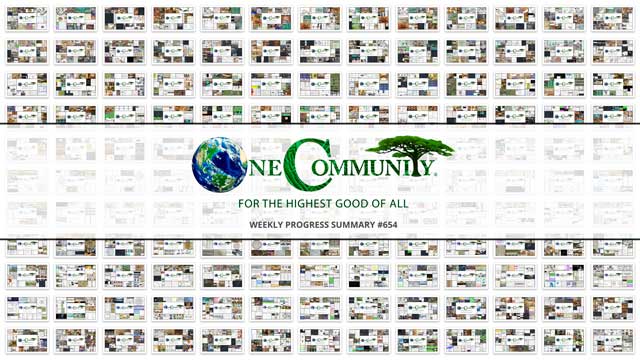
OUR MAIN OPEN SOURCE HUBS
Click on each icon to be taken to the corresponding Highest Good hub page.
One Community’s physical location will forward this movement as the first of many self-replicating teacher/demonstration communities, villages, and cities to be built around the world. This is the September 29, 2025 edition (#654) of our weekly progress update detailing our team’s development and accomplishments:
Open Sourcing the World We Want
One Community Progress Update #654
DONATE | COLLABORATE | HELP WITH LARGE-SCALE FUNDING
CLICK HERE IF YOU’D LIKE TO RECEIVE AN EMAIL EACH WEEK WHEN WE RELEASE A NEW UPDATE
YOU CAN ALSO JOIN US THROUGH SOCIAL MEDIA
ONE COMMUNITY WEEKLY UPDATE DETAILS
HIGHEST GOOD HOUSING PROGRESS
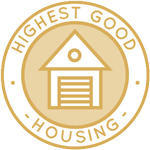 One Community is open sourcing the world we want through Highest Good housing that is artistic and beautiful, more affordable, more space efficient, lasts longer, DIY buildable, and constructed with healthy and sustainable materials:
One Community is open sourcing the world we want through Highest Good housing that is artistic and beautiful, more affordable, more space efficient, lasts longer, DIY buildable, and constructed with healthy and sustainable materials:
- Learn about: Our Upcoming Crowdfunding Campaign
- Learn about the different village models: 7 Sustainable Village Models
- Visit the open source portals for the first two: Earthbag Village OS Hub | Straw Bale Village OS Hub
This week, Ajay Adithiya Kumar Elancheliyan Tamilalagi (Mechanical Engineer) continued working on the main structure for the Earthbag Village. He completed the ventilation system design covering the selection and placement of fans, planning the layout and routing of ducts, and integrating odor removal filters into the system. Ajay also worked on defining airflow requirements, identifying suitable filter configurations, and ensuring that the overall design supports effective ventilation and odor control. One Community’s open source designs for open sourcing the world we want begins with the Earthbag Village, the first of seven planned villages providing housing. See below for some of the pictures related to this work.
Baraka Minja (Civil and Environmental Engineer Pr. Eng.) continued working on the Vermiculture Toilet drawings to bring them to construction-ready level. He added a reference layout to link additional door details and the door schedule. A dimension plan was included to show relative measurements to nearby structures, and additional north and south typical elevations were added to to the existing set. As the first of seven planned villages, the Earthbag Village provides the initial housing within One Community’s open source designs for open sourcing the world we want. See the work in the collage below.
Derrell Brown (Plumbing Designer) continued working on the Earthbag Village final MEP report by gathering mechanical reference information related to design and calculation breakdowns. He reviewed the latest plumbing plans to update the process of plumbing design, including project information, design considerations, and supporting formulas. Derrell also focused on collecting data on fixtures and water supply fixture units to support the calculation of the domestic water entry. One Community’s open source designs for open sourcing the world we want begins with the Earthbag Village, the first of seven planned villages providing housing. See below for some of the pictures related to this work.
Fangting Xu (Interior Design Intern) continued working on the ADA code requirements for the Earthbag Village. She researched ADA code requirements for the connections between buildings to ensure compliance and accuracy and applied accessibility standards to the project. Fangting also hosted the weekly team meeting, discussed improvements with Jae, and updated the orientation file accordingly. One Community’s open source designs for open sourcing the world we want begins with the Earthbag Village, the first of seven planned villages providing housing. See below for some of the pictures related to this work.
Karthik Pillai (Mechanical Engineer) continued work on the Vermiculture Toilet, concentrating on finalizing the design of the waste dumping mechanism. He modified and refined the initial concept to bring the design to its final completed version. In parallel, he contributed to the integration of the full vermiculture toilet facility within the HVAC project framework, laying the groundwork for his teammates to proceed with related tasks. Additionally, Karthik continued work on the Earthbag Village 4 dome cluster roof project, making revisions to the project report in line with feedback and instructions provided by the core team. As the first of seven planned villages, the Earthbag Village provides the initial housing within One Community’s open source designs for open sourcing the world we want. See the work in the collage below.
Malhar Solanki (Mechanical Engineer) worked on the Earthbag Village tasks originally assigned to another team member due to their unavailability. He managed all scheduled team meetings and adjusted the status of all project tasks according to current progress. Further, he completed the Bill of Materials (BOM) for all required fasteners was completed, and started work on the selection and specification of off-the-shelf equipment for the Heating, Ventilation, and Air Conditioning (HVAC) system. The Earthbag Village, the first of seven planned villages, serves as the initial housing component within One Community’s open source framework for open sourcing the world we want. See below for some of the pictures related to this work.
Michaela Silva (Architect) continued working on details in the construction documents of the Earthbag Village, working on modeling and detailing the window headers. She created structural column dimension plans for the dining room and living room windows, along with a header plan for the living room window. She also created a header plan for the bedroom windows. In addition, Michaela created a new sheet for window details and reorganized the windows, placing those in the dome on one sheet and those in the vertical earthbag walls on another. The Earthbag Village, the first of seven planned villages, serves as the initial housing component within One Community’s open source framework for open sourcing the world we want. See below for some of the pictures related to this work.
Rahul Kulkarni (Mechanical Engineer) continued work on the Vermiculture Toilet waste water channel design. He alos began work on a revised design that directs wastewater from the vermiculture chamber straight into the septic tank based on the suggested corrections. Following clarification on the drainage approach, he initiated CAD modeling for the drain under the vermiculture chamber. The new wastewater dumping design was formalized, and he made adjustments to refine the drawer modification. The feasibility of the CAD model was reviewed in relation to the other parts of the assembly from a DFMA perspective, and a basic CAD outline of the wastewater dumping mechanism was created. The Earthbag Village, the first of seven planned villages, serves as the initial housing component within One Community’s open source framework for open sourcing the world we want. See below for some of the pictures related to this work.
Rishi Chakrapani (Mechanical Engineer) continued working on the Vermiculture Toilet, re-modeling the winch from the separator insertion platform with a higher gear ratio to be used for pulling out the drawer. He also remodeled a sloped drainage tray with gutters to redirect solid waste to the main chamber and liquid waste to the filtration unit, with a concept sketch attached and CAD development in progress. The Earthbag Village, the first of seven planned villages, serves as the initial housing component within One Community’s open source framework for open sourcing the world we want. See below for some of the pictures related to this work.
DUPLICABLE CITY CENTER PROGRESS
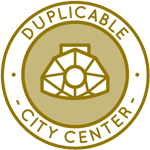 One Community is open sourcing the world we want through a Duplicable and Sustainable City Center that is LEED Platinum certified/Sustainable, can feed 200 people at a time, provide laundry for over 300 people, is beautiful, spacious, and saves resources, money, and space:
One Community is open sourcing the world we want through a Duplicable and Sustainable City Center that is LEED Platinum certified/Sustainable, can feed 200 people at a time, provide laundry for over 300 people, is beautiful, spacious, and saves resources, money, and space:
- Learn about this building and it’s function: Duplicable City Center Open Source Hub
This week, Anjana Reddy (Architectural Designer) continued work on the Duplicable City Center by finalizing and submitting renderings and exterior walkthrough files for the animal section. She reviewed previous renderings to correct perspectives, material refinements, distortions, and proportions, addressed feedback on the water tower, and began organizing project files from SketchUp and Lumion while initiating work on the landscape area. This open-source Duplicable City Center project contributes to developing open sourcing the world we want. For more details, refer to the image below.
Ayushman Dutta (Mechanical Engineer) continued working on the Duplicable City Center hub connector by formatting the report for the manufacturing document and making changes to the Excel sheet comparison of the hub connector slots. He finished the material sheet and attended the weekly team meeting to discuss roadblocks. Ayushman also made corrections in the hub connector FEA model and began working on the FEA analysis of the hub connector for the third row, encountering software issues that he resolved by reinstalling the software. He imported the geometry for the row 3 hub connector, cleaned the geometry, and prepared the model for FEA analysis. This open-source Duplicable City Center project is open sourcing the world we want. For more specifics, view the image below.
Nikhil Bharadwaj (Mechanical Engineer) continued working on the Duplicable City Center dome assembly by drafting the 2D flattened drawings for each spoke to aid fabrication and assembly, and then adding these drawings to the assembly spreadsheet. He integrated the row 3 hub connector into the complete dome assembly, cut beams to create the required clearances and fit, and obtained the beam cut angles while adding color-coded screenshots to the spreadsheet. He connected with Nupur to finalize the row 3 assembly spreadsheet, manage the handoff, understand the procedure for drafting the assembly document, and obtain all related files. Meanwhile, the work for the row 4 hub connector design continued. One Community’s Duplicable City Center is an example of open sourcing the world we want. Here are a few pictures that showcase this work.
Sandesh Kumawat (Mechanical Engineer) continued working on the City Center Natural Pool and Eco-spa Designs for the Duplicable City Center focusing on meshing the full spa assembly in ANSYS and building separate meshes for the cover panels, tub shell, and outer body. He organized material properties, validated mesh quality, defined mesh controls, grouped contact pairs, and prepared loads and boundary placeholders, documenting all final element counts and updating shared files. Discover One Community’s open-source Duplicable City Center for open sourcing the world we want. The following visuals illustrate highlights from this effort. Discover One Community’s open source Duplicable City Center for open sourcing the world we want. The following visuals illustrate highlights from this effort.
Vineela Reddy Pippera Badguna (Mechanical Engineer) continued her in-depth research on greywater reuse systems for the Duplicable City Center. She reviewed a document on LEED points strategy as well as one on Green Infrastructure and Stormwater Best Management Practices. In addition, she analyzed the Earthbag Village stormwater and rainwater harvesting spreadsheets to better understand and refine the calculations. Vineela also updated the greywater catchment calculations in the spreadsheet by referencing Earthbag Village rainwater catchment data and carefully cross-verifying the details to ensure complete accuracy. This open source Duplicable City Center project is part of open sourcing the world we want. For more details, refer to the image below.
HIGHEST GOOD FOOD PROGRESS
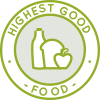 One Community is open sourcing the world we want through Highest Good food that is more diverse, more nutritious, locally grown and sustainable, and part of our open source botanical garden model to support and share bio-diversity:
One Community is open sourcing the world we want through Highest Good food that is more diverse, more nutritious, locally grown and sustainable, and part of our open source botanical garden model to support and share bio-diversity:
- Learn about the structures: Hoop House Hub | Aquapini & Walipini Open Source Hub
- See what we’ll be growing: Gardens & Hoop Houses | Large-scale Structures | Food Forest | TA
This week, the core team continued working on the Master Tools, Equipment, and Materials and Supplies List for the Large Garden and Botanical Garden. They added the required fencing supplies to the Large Garden, Botanical Garden, and Orchard project documents. Concurrently, a review of the Master Tools, Equipment, Materials/Supplies (TEMS) document was continued to ensure accurate alignment with the Botanical Garden document specifications. The Highest Good Food initiative is a key component of One Community’s open source plans, focused on open sourcing the world we want, and exemplifies the organization’s commitment through innovative design and implementation. Below are some images showcasing this work.
The core team also continued contributing to the Highest Good Food initiative. The team finished reviewing and making final edits to the food bars, food procurement and storage, sustainable nutrition calculations, food self-sufficiency plan, and transition kitchen pages. They also did an initial read-through to familiarize themselves with the “What is a solar energy microgrid?” page and the calculation tool associated with it. In addition, they reviewed the report comparing off-grid and grid-tie systems. The Highest Good Food initiative plays a leading role in One Community’s open source platform by promoting sustainable and participatory development focused on open sourcing the world we want. Below are images related to this project.
Chelsea Mariah Stellmach (Project Manager) continued her work on the Transition Food Self-sufficiency Plan. She created circular logo-style icons including versions for Food Procurement & Storage and Recipe Buildout Tool, revising text and adjusting designs such as adding a chef’s hat and matching backgrounds to the original style. Chelsea sent these mock ups and further instructions to Shireen and Tyson to finalize. She produced a detailed to-do list for immediate and long-term tasks. Chelsea also worked on food bar section drafts by polishing and formatting the Cold Foods section, writing introductions and formatting items for Hot Foods, Sauces and Miscellaneous Toppings, and Liquids sections, and ensuring consistent professional structure across all sections. As an essential aspect of One Community’s open source goals, the Highest Good Food initiative supports open sourcing the world we want. Below are some images showcasing this work.
Dirgh Patel (Mechanical Engineer) continued assisting with the Climate Battery design updates. He calculated the cooling airflow required to maintain 0 °C, including total heat gain in kWh per day, average power in kW, required flow rate in cubic meters per second, required CFM, ACH per hour, and air volumes per minute for all months. Dirgh then edited the final report and worked on finding connections between heating, ventilation, battery design, and temperature changes across all months to demonstrate how the battery design will react. He calculated the ground temperature, total heat gain, average power, temperature difference, required volume flow rate, required CFM, ACH, and volumes per minute for all months to maintain 30 °C and 24 °C inside the greenhouse. Dirgh created a table with the ground temperature, total heat gain, average power, temperature difference, required volume flow rate, required CFM, ACH, and volume per minute for all months to maintain 30 °C, 24 °C, and 0 °C inside the greenhouse, illustrating how heat and ventilation interact with the battery design. One Community’s open-source mission is powerfully reflected in the Highest Good Food initiative, which is focused on open sourcing the world we want. The following visuals illustrate highlights from this effort.
Faeq Abu Alya (Architectural Engineer) continued developing house designs for the Earthbag Village 4-dome cluster project. He worked on the 254 aquapini and walipini project, continuing the design of homes in the Southwest and Southeast with a focus on upgrading materials and improving overall appearance. The tasks included refining design components, applying updated features, and enhancing visual presentation to ensure the models reflected project standards. The Earthbag Village is the first of seven planned villages to be constructed as part of One Community’s open source model for open sourcing the world we want, and it is closely tied to the Highest Good Food initiative. Below are some pictures related to this work.
Gayatri Pandkar (Architect) continued contributing to the Highest Good Food initiative. She focused on refining the Walipini structure, implementing the suggested changes and completing the report on the people spaces. Gayatri updated the SketchUp model with some adjustments, including reducing the width of the pathways and replacing the wooden benches with stone benches. These refinements improved functionality, circulation, and user experience while enhancing integration with the surrounding environment, creating a more cohesive and context-sensitive design that responds effectively to both the landscape and intended social interactions. The Highest Good Food initiative is a key part of One Community’s open source platform, focused on sustainable and participatory development while open sourcing the world we want. Below are visuals highlighting this work.
Jay Nair (BIM Designer) continued on Aquapini and Walipini Planting and Harvesting documents. He worked on standardizing the format of the lighting energy calculation document and began developing a concept design for the user interface of the lighting energy calculation software. The standardization process included aligning headings, spacing, and data presentation with webpage formatting. The UI concept focused on structuring user input fields, defining calculation output displays, and outlining essential functional components for greenhouse lighting analysis. The Highest Good Food initiative is a key part of One Community’s open source platform, focused on sustainable and participatory development while open sourcing the world we want. See below for pictures related to this work.
Keerthi Reddy Gavinolla (Software Developer) continued working on the Highest Good Food page. She updated the City Center Team Blog #653. Keerthi made changes to the Soil Amendment and Initial Off-grid Site Preparation page in the Google Document as per Jae’s review, including adding h3 and h6 tags to the needed headings. She also started implementing these edits into the website and completed her admin work for the week. Built on One Community’s open source foundation, the Highest Good Food initiative is dedicated to open sourcing the world we want, empowering communities through self-sustaining systems. View examples of her work in the pictures below.
Nitin Parate (Architect) continued contributing to the Highest Good Food initiative. He worked on updating the 3D files of the Aquapini and Walipini site, with most of the modeling already completed. Tasks focused on surface building and applying minor corrections to refine the model, improve accuracy, and ensure alignment with overall project requirements. The surfaces of the 3D file were updated, though rendering work is still pending. In addition, Nitin held a discussion with Shivangi regarding the updates required for the 2D CAD file to maintain consistency and accuracy across drawings and support coordination with the broader project scope. The Highest Good Food initiative is a key part of One Community’s open source platform, promoting regenerative and participatory development while open sourcing the world we want. Images below showcase his contributions.
Pallavi Deshmukh (Software Engineer) continued working on the Aquapini and Walipini Planting and Harvesting pages. She created new content for blog 653 and worked with her teammates by reviewing their input and integrating feedback to maintain a clear and consistent final version. After applying Jae’s recommendations, she completed the integration of Zenapini #2 content from Silin. Pallavi then moved on to Walipini #2, where she incorporated Junyi Shi’s contributions by updating the page with revised text, links, and images. In alignment with One Community’s open source objectives, the Highest Good Food project integrates the concept of open sourcing the world we want into a larger vision of regenerative living. Her contributions are highlighted in the collage below.
Shivangi Varma (Volunteer Architectural Designer And Planner) continued contributing to the Highest Good Food. She edited the text and graphic content for the Planting and Harvesting page. Shivangi also developed the master plan render for the Highest Good Food Infrastructure project and the six structures of Aquapini, Walipini and Zenipini on Adobe Illustrator and Photoshop in coordination with the volunteer architect. The Highest Good Food initiative plays a leading role in One Community’s open source platform by promoting sustainable and participatory development focused on open sourcing the world we want. Below are visuals highlighting this work.
HIGHEST GOOD ENERGY PROGRESS
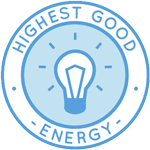 One Community is open sourcing the world we want through Highest Good energy that is more sustainable, resilient, supports self-sufficiency and includes solar, wind, hydro and more:
One Community is open sourcing the world we want through Highest Good energy that is more sustainable, resilient, supports self-sufficiency and includes solar, wind, hydro and more:
- Learn about the open source sustainable-energy foundations: Solar, Hydro, and Wind
- Explore our research into the most sustainable products and companies for saving water and energy: Insulation, Eco-laundry, Lightbulbs and Light Bulb Companies, Doors and Door Companies, Windows and Window Companies, Toilets, Faucets and Faucet Accessories, Urinals, and more.
This week, Shravan Murlidharan (Electrical Engineer) continued supporting the Highest Good Energy initiative. He focused on reorganizing and refining the One Community Solar webpage with attention to optimizing the presentation of tables and charts and ensuring that the content was arranged in a logical structure. In addition to webpage improvements, effort was directed toward updating and refining the related spreadsheet to align calculations and data presentation with the website content. Work also included development and adjustments to the solar cost analysis tool to make it more functional for users. Finally, tutorials were reviewed and updated to provide clearer guidance on using the tool and interpreting the results. One Community’s open source mission is powerfully reflected in the Highest Good Energy initiative, which supports open sourcing the world we want as a model for global impact. Images below showcase this work.
HIGHEST GOOD EDUCATION PROGRESS
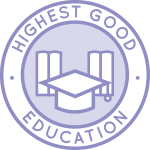 One Community is open sourcing the world we want through Highest Good education that is for all ages, applicable in any environment, adaptable to individual needs, far exceeds traditional education standards, and more fun for both the teachers and the students. This component of One Community is about 95% complete with only the Open Source School Licensing and Ultimate Classroom construction and assembly details remaining to be finished. We’ll report on the final two elements to be finished as we develop them. With over 8 years of work invested in the process, the sections below are all complete until we move onto the property and continue the development and open sourcing process with teachers and students – a development process that is built directly into the structure of the education program and everything else we’re creating too:
One Community is open sourcing the world we want through Highest Good education that is for all ages, applicable in any environment, adaptable to individual needs, far exceeds traditional education standards, and more fun for both the teachers and the students. This component of One Community is about 95% complete with only the Open Source School Licensing and Ultimate Classroom construction and assembly details remaining to be finished. We’ll report on the final two elements to be finished as we develop them. With over 8 years of work invested in the process, the sections below are all complete until we move onto the property and continue the development and open sourcing process with teachers and students – a development process that is built directly into the structure of the education program and everything else we’re creating too:
- Program Overview: Education Open Source Hub
- How the components work together in designing human orchestrated eco-abundance: How to use the Education for Life Program
- Lesson Plans for Life – Lesson Plans How-to
- Foundations of Outstanding Leaders, Teachers, and Communicators
- Curriculum for Life
- Teaching Strategies for Life
- Learning Tools and Toys for Life
- Evaluation and Evolution
This week, Anuneet Kaur (Administrator) continued contributing to the Highest Good Education software platform by creating Figma design elements and refining the visual layout, supporting One Community’s dedication to open sourcing the world we want. She updated the redo assignments UI and project manager dashboard based on Harshitha’s feedback, improving usability and ensuring consistency with project standards. Anuneet also researched sustainable resources by reviewing scholarly articles and compiling statistics for the graphic process. She reviewed Yulin’s infographic on sustainable research and provided feedback. Additionally, she ensured all members were included in the live blog task, drafted content, and selected images for the Highest Good Education Program Licensing and Accreditation webpage. Her administrative contributions included editing summaries and collages for the Highest Good Society team, Highest Good Education team, and the core team, while reviewing fellow admins’ submissions for accuracy and completeness. The One Community model of open sourcing the world we want, exemplified by sustainably built classrooms like these, fosters lasting global impact. Her recent contributions are featured in the collage below.
Harshitha Rayapati (Program Manager) continued advancing the Highest Good Education platform by detailing deliverables, developing Figma designs, and expanding the visual layout of the student dashboard. She worked on assigning PRs to Vivek, Sphurthy, and Raahul, clarifying their questions, and updating the HGN Phase 4 document as needed. She assigned new tasks to Srushti and Ravi to develop Figma designs for immediate deliverables. Figma screenshots were attached to action items in the deliverables for developers to reference in the HGN Phase 4 document. Harshitha reviewed the HGN website to understand the objectives of Phase 5 and examine the technical goals and Phase 5 project document. Tasks were added and more details were provided for Deliverable 5 in Phase 4. Additionally, she worked on compiling the weekly blog update, reviewed the Housing team’s weekly progress, edited the blog page and included admin’s feedback. The One Community model of open sourcing the world we want, exemplified by sustainably built classrooms like these, advances meaningful global change. The collage below highlights her recent contributions.
Ravi Kumar Sripathi (Software Engineer) continued developing the Highest Good Education software platform by creating Figma designs and refining the Build Lesson Plan module, which enables students to transform their saved interests into weekly learning plans through guided steps. He worked on designing the task card functionality within the learning platform. After atoms and topics were selected, activities were auto-populated on the screen, and he defined how each task would be displayed and interacted with. The task card design included the task name, a pre-filled description, a student-editable reflection box labeled “Why I Chose This,” and a dropdown for strategy suggestions generated from preferred teaching and learning methods. This work focused on shaping the student experience and establishing a clear structure for task engagement. These updates strengthened both the functionality and user experience of the platform, enhancing the One Community model of open sourcing the world we want as a path to lasting global impact. Below are images related to his work.
HIGHEST GOOD SOCIETY PROGRESS
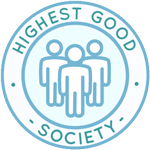 One Community is open sourcing the world we want through a Highest Good society approach to living that is founded on fulfilled living, the study of meeting human needs, Community, and making a difference in the world:
One Community is open sourcing the world we want through a Highest Good society approach to living that is founded on fulfilled living, the study of meeting human needs, Community, and making a difference in the world:
- Read the Highest Good society overview: Highest Good Society
- Learn about the model for fulfilled living and sharing: A Day in the Life
- Learn about the 4 economic models: RBE | For-profit | Non-profit | Entrepreneurship
- Learn about our open source community collaboration and management software: The Highest Good Network
This week, the core team completed over 52 hours managing volunteer work reviews, handling emails, overseeing social media accounts, supporting web development, identifying new bugs, integrating bug fixes for the Highest Good Network software, and interviewing and onboarding new volunteer team members. They also produced and integrated the video above, highlighting how open sourcing the world we want serves as the foundation of One Community’s broader mission. The following images showcase highlights of this work.
Govind Sajithkumar (Project Manager) continued focusing on analytics and content management for Meta’s Facebook and Instagram channels. He managed the social media content rotation for Meta platforms by preparing, scheduling, and refreshing the Facebook and Instagram feeds with a regular batch of new posts. He set up the posting schedule and recorded all new content details in the Open Source spreadsheet. Govind also performed the weekly update of social media analytics by collecting and processing new audience data for both platforms. Additionally, he completed PR Review Team Management by modifying a WordPress site with the team’s weekly summary and collage, filling the PR Review Team Table, and updating the Highest Good Network PR spreadsheet. He submitted his admin feedback table, which further supports One Community’s mission of open sourcing the world we want. The images below highlight key aspects of his contributions.
Jaiwanth Reddy Adavalli (Project Manager) continued developing the Job Applicants page and key components of the Highest Good Network Phase 2 and Phase 4 dashboards, including the PR Team analytics section. He worked on the Phase 2 Dashboard by editing the design and action items for several components. He tracked updates in software team management documents to support task management. Jaiwanth also tested multiple pull requests in the Highest Good Network software. As a member of the pull request review team, he reviewed submissions from the volunteer team assigned to him. This work supports One Community’s commitment to open sourcing the world we want. The images below highlight his contributions.
Rajrajeshwari Gangadhar Sangolli (Data Analyst) continued working on Google Ads management and strategy evolution. She changed goals for underperforming campaigns, reviewed over 30 low-performing ads, applied Google recommendations, and adjusted budgets and keywords. She created 9 new ad groups and a new campaign for sustainable products, documented changes in Google Sheets, and optimized ongoing campaigns. Rajrajeshwari collaborated with Sudarshan and Mridul on process issues, converted problems into tasks, and rechecked work with Jae’s guidance. She tested 4 merged PRs, commented on others needing changes, coordinated with another tester, created a new testing account, and added tasks for review. She also completed admin work for 12 volunteers, tested materials and equipment pages, added 5 new data points, created 2 purchase orders, and verified chart functionality on the dashboard. This project supports One Community’s commitment to open sourcing the world we want. The images below highlight key aspects of her work.
Yagna Reddy Badvel (Data Analyst and Team Administrator) began working on the Summary Dashboards and Weekly Report page on the Highest Good Network. He worked on validating the Team Stats and Total Org Summary dashboards. He reviewed the Team Stats chart values showing In Team = 136 and Not in Team = 71, compared them against the Leaderboard HGN total of 189, and cross-checked member lists across 54 teams. He identified duplicate entries where the same user was counted multiple times with different join dates and documented the defect root cause as membership rows being counted instead of unique userIds. A detailed defect report was prepared with a problem statement, steps to reproduce, expected versus actual results, and acceptance criteria. After Jae provided access to Prod Teams, Yagna revalidated team counts by opening individual team pages and confirmed that the dashboard totals now matched the actual team memberships, noting that full access made reconciliation possible. He also continued testing other Org Summary components, including Submitted Summaries and Assigned Hours, but highlighted the difficulty of verifying totals due to more than 777 records in the Weekly Summaries Report with no filters, and prepared an explanation of this limitation to share with Jay. In addition, he carried out admin activities by reviewing weekly summaries, checking media folders, posting document comments, and updating tracking tables for missing items. A Priority High issue was also logged for the Total Org Summary Role Distribution Pie Chart, which updates correctly for the current week but does not refresh for previous weeks, with a request submitted to incorporate proper date-filter logic so the chart reflects the selected range. This work supports One Community’s commitment to open sourcing the world we want. The images below highlight his contributions.
ADMINISTRATION TEAM
The Administration Team’s summary, which covers their work on the Highest Good Network, was managed by Prudhvi Marpina (Data Analyst) and includes Ashutosh Mishra (Software Engineer), Divanshu Bakshi (Team Admin), Georgina George (Business Intelligence Analyst), Indra Anuraag Gade (Software Engineer and Team Administrator), Keerthana Chitturi (System Administrator), Mridul Bhushan (Volunteer Project Strategy Analyst and Team Administrator), Neeharika Kamireddy (Data Analyst), Olimpia Borgohain (Data Analyst and Team Administrator), Olawunmi “Ola” Ijisesan (Administrative and Management Support), Rachna Malav (Data Analyst), Rajeshwari Bhirud (Administrator), Rishitha Adepu (Administrator), Sai Suraj Matta Veera Venkata (Business Data Analyst), Samhitha Are (Administrator), and Sudarshan Raju Chintalapati Venkata (Data Analyst). The Administration Team supports the Highest Good Network, a tool designed to manage and objectively measure progress while building open-source solutions for global sustainability. Through administrative support, documentation, testing, training, recruiting, analytics, and content management, the team directly contributes to open sourcing the world we want and to One Community’s mission of building a replicable model for a sustainable future.
This week, Ashutosh corrected the image multimodal vector representation for chatbot MCP processing, reviewed volunteer action items, refactored TimeLog Administrator documents, and tested Supabase integration. Divanshu tested and validated HGN pull requests, coordinated task assignments, researched Mastodon strategies, and managed documentation and blogs, contributing to open sourcing the world we want. Georgina created and cross-posted Reddit content, collected Reddit data with Python, cleaned the dataset, and developed a visualization dashboard. Indra completed local HGN setup, tested frontend and backend, reviewed PRs 4002 and 3977, advanced the X/Twitter Analytics Dashboard, scheduled posts, and prepared Blog #653 for CODE CRAFTERS, supporting the mission of open sourcing the world we want. Keerthana reviewed team submissions, prepared the weekly blog, completed Step 2 and Step 4 documents, and contributed to Phase 3 testing with validation and documentation. Mridul managed summaries, optimized collages, generated SEO text, updated the HGN Questionnaire, refined webpage formatting, and collaborated with Sudarshan and Rajeshwari on testing PRs 3976, 3864, 3738, 3488, 3678, and 3254. Neeharika assigned tasks by reviewing management documents, followed up on progress, tested PRs, and reviewed two admins’ work, reflecting the team’s focus on open sourcing the world we want.
Ola monitored team management data, prepared the admin workspace, updated quality metrics, and submitted the weekly report with images. Olimpia oversaw senior admin responsibilities, resolved past comments, flagged issues, analyzed LinkedIn analytics, created graphs, and edited documentation, supporting open sourcing the world we want. Rachna had no new interview scheduling emails, so she caught up on old tasks, revisited emails and comments, and reviewed webpages for updates. Rajeshwari, as Administrator for Blog #653, reviewed summaries, edited the WordPress blog with collages, updated the HGN questionnaire, uploaded corrected files, and tested two UI-related dev environment issues. Rishitha assisted with blog corrections, updated bios, followed up on missing details, uploaded media on Threads, and reviewed her weekend work. Sai Suraj enhanced the Social Media Analytics Dashboard by expanding tabs, developing a volunteer tracker, fixing dashboard components, and updating formatting, while also compiling summaries, organizing images, creating collages, and finalizing the updated webpage—an action that highlights One Community’s commitment to open sourcing the world we want. Samhitha reviewed Divanshu and Sudarshan’s blog, provided detailed feedback, performed Phase 3 testing across accounts, refined the testing process, and recommended improvements. Sudarshan worked on the Alpha Software Team blog with SEO updates and collages, reviewed multiple PRs, validated dashboard data, and coordinated meetings to plan assignments and feedback. To learn more about how this work contributes to open sourcing the world we want, visit the Highest Good Society and Highest Good Network pages. Highlights of the team’s contributions are shared in the collage below.
GRAPHIC DESIGN TEAM
The Graphic Design Team’s summary includes Qinyi Liu (Graphic Designer) and Yulin Li (Graphic Designer), who focused this week on creating graphic designs that support open sourcing the world we want.
This week, Qinyi created and updated bio images and announcements, adding them to the website with prepared visuals as part of open sourcing the world we want. Yulin focused on visual communication and coordination tasks, revising 3 infographics and 10 volunteer announcements. She also prepared and posted the Highest Good Network software team collaboration announcement, maintained organized asset management via Dropbox, and joined weekly review discussions. Their combined efforts highlight open sourcing the world we want. See the Highest Good Society pages and the collage below for examples of their work.
HIGHEST GOOD NETWORK PROGRESS
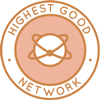 One Community is open sourcing the world we want through open source Highest Good Network® software that is a web-based application for collaboration, time tracking, and objective data collection. The purpose of the Highest Good Network is to provide software for internal operations and external cooperation. It is being designed for global use in support of the different countries and communities replicating the One Community sustainable village models and related components.
One Community is open sourcing the world we want through open source Highest Good Network® software that is a web-based application for collaboration, time tracking, and objective data collection. The purpose of the Highest Good Network is to provide software for internal operations and external cooperation. It is being designed for global use in support of the different countries and communities replicating the One Community sustainable village models and related components.
- Learn about our open source community collaboration and management software: The Highest Good Network
This week, the core team continued working on the Highest Good Network software by completing and confirming several pull request fixes. Implementation of a job analytics graph (#3675), placement of tracking buttons on small screens with updates to the Warning.css file (#3651), the application time chart with role and date filtering (#3609), the Job CC feature for all categories (#3592), profile page data justification and WBS task number updates (#3715), the project page archive button dark mode issue (#2981), updated people count in reports (#3712), clock icon misalignment and horizontal scroll in team member tasks (#3718), addition of a timelog shortcut to the User Management page (#3701), border and justification issues in the profile page (#3722), and timelog formatting errors (#3723).This effort contributes to One Community’s focus on open sourcing the world we want.
Issues not fixed included copy question sets (#3433+1409), feedback on registration status (#3105), start/end date format, validation, and date picker overflow issues (#2915), and the creation of a line chart showing total rental costs over time in the backend (#1411). Additional work included providing more detailed descriptions for developers about previously reported issues such as fixing colors for dark mode, reporting a new bug related to the disappearance of the Team table when the screen width changes, reviewing assigned badges for “Tester One” with 5 hours logged and the same data and badge count issues for the “New Max” badge as noted in previous weeks, and assigning a new task to one volunteer. See the Highest Good Society and Highest Good Network pages for more on how this work strengthens open sourcing the world we want.
ALPHA SOFTWARE DEVELOPMENT TEAM
The Alpha Team’s summary, presenting their work on the Highest Good Network software, was managed by Lin Khant Htel (Frontend Software Developer) and included Carlos Martinez (Software Developer) and Nikita Kolla (Full Stack Developer). The Highest Good Network software is a key part of open sourcing the world we want to build, helping track and measure progress toward creating a sustainable world. The software supports social architecture, construction, production, and maintenance processes that contribute to the open source project and resilient ecosystems. Designed to be portable and scalable, the Highest Good Network software is well suited for off-grid and sustainable living communities. This project reflects One Community’s open source commitment to advancing the idea of open sourcing the world we want to build.
Lin managed the Alpha Team summary, reviewed PR #1746, checked the code, tested it with Postman API, confirmed the results as expected, reviewed weekly summaries, photos, and videos submitted by team members, carried out management duties, and led the weekly online meeting. This outcome reflects One Community’s strategy for open sourcing the world we want. Carlos worked on the phase 3 registration search features for events, adding filtering options by type, date, and location, updated the search functionality to be case insensitive, and converted the existing CSS to module CSS to minimize the risk of unintended style changes affecting other areas of the site, he also reviewed the pull requests 4074, 4092, 4124, 4125 + 1757, and 4128. Nikita continued work on the task “Total Org Summary: Fix stats accuracy (NEW),” which addressed discrepancies between the statistics shown on the Total Org Summary page and those on the Reports > Reports page, documented the issues, investigated their causes, and prepared supporting documentation while considering possible solutions. See the Highest Good Society and Highest Good Network pages for more on how this contributed to the mission of open sourcing the world we want to build. See the image below to view the team’s work.
BINARY BRIGADE SOFTWARE DEVELOPMENT TEAM
The Binary Brigade Team’s summary, presenting their work on the Highest Good Network software, was managed by Nikhil Routh (Software Engineer) and included Abhishek Srikanth (Software Engineer), Deep Shah (Software Engineer), Kanishk Agarwal (Software Engineer), Ramsundar Konety Govindarajan (Software Engineer), Harsha Rudhraraju (Software Engineer), Sourabh Bagde (Software Developer), Srushti Patel (Software Developer), Manvi Kishore (Software Engineer), Taariq Mansurie (Full-Stack Developer), Xinyi Zhou (Developer) and Rohit Mamidi (Software Engineer). The Highest Good Network software is our tool for managing and objectively measuring progress, ensuring that all contributions are tracked, aligned with our mission, and open sourcing the world we want.
This week, Abhishek fixed a bug with the role distribution pie chart so it now updates correctly with date filters, added a loader for data fetching, and reviewed several pull requests. Deep added a mentor-specific pie chart to the Volunteer Status section by updating both backend aggregation logic and frontend components. Harshavarma resolved multiple merge conflicts, validated functionality across paired frontend and backend pull requests, and streamlined the PR review process. Kanishk advanced Phase 3 of the Event Popularity Analytics landing page by fixing routing issues, converting components to CSS modules, and reviewing prior code for optimizations. Manvi tested Pinterest auto-posting but encountered Node, CORS, and login issues tied to recent merges. Ram expanded the task assignment list from 5 to 10 people, investigated a report page timer bug, and began implementing a new plus/minus profile permission. This progress demonstrates One Community’s commitment to open sourcing the world we want.
Rohit documented the badge validation workflow and built reusable scripts to simulate time- and event-driven badge conditions. Sourabh created initial Figma frames and completed the UI for the Slashdot auto-poster, pending admin approval for testing. Srushti completed the Assign Lesson Plan Figma screens and began designs for logging hours across multiple tasks. Taariq resolved merge conflicts, improved email and filterColor functionality, and initiated setup for the Education Portal. Xinyi fixed errors with the “All Time” volunteer trends chart and investigated latency issues in the aggregation query. These combined efforts support One Community’s long-term goal of open sourcing the world we want. See the Highest Good Society and Highest Good Network pages for more about how this relates to open sourcing the world we want. The collage below shows images of their work.
BLUE STEEL SOFTWARE DEVELOPMENT TEAM
The Blue Steel Software Team, working on the Highest Good Network software, was managed by Divanshu Bakshi (Product Manager) and includes Linh Huynh (Software Engineer), Felix Huang (Software Engineer), Humemah Khalid (Software Engineer/Backend Developer), and Sheetal Mangate (Software Engineer).
This week, Felix resolved issues with WBS categories not assigning correctly after page refreshes by refining the business logic to distinguish between default categories and user overrides. He then revised the code so refreshed pages now retain correct task categories, supporting One Community’s goal of open sourcing the world we want. Linh implemented and debugged unit tests for the taskEditSuggestionController, mocking model dependencies and creating cases for both success and failure scenarios. He also reviewed and tested the taskNotificationController, patched a bug with deleteTaskNotificationByUserId, and improved error handling, reinforcing One Community’s goal of open sourcing the world we want.
Humemah worked on backend API updates for the “Set Final Day” permission by reviewing where permissions are stored in the user profile schema and planning validation logic to ensure smooth integration. Sheetal managed the weekly summary and improved server-side validation for Reddit post submissions by adding logic to distinguish between link and media formats. She ensured link submissions function correctly while debugging issues with media submissions, with both efforts contributing to One Community’s commitment to open sourcing the world we want. See the Highest Good Society and Highest Good Network pages for more on how this relates to our mission of open sourcing the world we want. Below are some images showcasing this work.
CODE CRAFTERS SOFTWARE DEVELOPMENT TEAM
The Code Crafters Team, covering their work on the Highest Good Network software, was managed by Indra Anuraag Gade (Software Engineer and Team Administrator) and includes Ajay Naidu (Software Engineer), Akshith Kumar Reddy Balappagari Gnaneswara (Software Engineer – Full Stack), Benitha Sri Panchagiri (Software Engineer), Chaitanya Swaroop Kumar Allu (Software Engineer), Juhitha Reddy Penumalli (Software Engineer), Rahul Bagul (Software Engineer), Sphurthy Satish (Software Engineer) and Vivek Chandra (Software Engineer). The Highest Good Network software is how we’ll manage and objectively measure our process for establishing abundant community systems through our social architecture, construction, production, and maintenance processes, and support widespread and lasting eco-lifestyle access. This effort exemplifies One Community’s open source commitment to open sourcing the world we want, creating pathways to a more regenerative and thriving future.
This week, Ajay resolved merge conflicts and completed styling tasks by creating a CSS module for the community portal activity page, while converting chart stylesheets to modules and verifying correct component display. Akshith tested multiple PRs, verified front-end changes, and provided feedback to ensure requests ran as intended. Benitha fixed over 100 broken import errors, switched to absolute imports, and began addressing new compile issues to streamline the codebase.
Chaitanya improved the email newsletter system by reorganizing its architecture, consolidating editors, and refining text and video content handling. Juhitha implemented components and refined the UI for Phase 2 of the Summary Dashboard, integrating APIs and resolving errors to ensure full functionality. Rahul advanced the naming convention task, integrating Stylelint and ES Modules while updating configuration and pre-commit files to prevent CSS conflicts. Sphurthy implemented backend logic for the Assign Lesson Plan feature, handling prerequisites, creating StudentTasks, updating StudentAtoms, and writing unit tests for multiple scenarios. Vivek reviewed and ran the authentication profile, resolved branch conflicts, and updated UML diagrams to reflect database changes. All of these contributions support One Community’s mission of open sourcing the world we want. See the Highest Good Society and Highest Good Network pages for more on how this relates to open sourcing the world we want. Below are some pictures of the team’s work.
DEV DYNASTY SOFTWARE DEVELOPMENT TEAM
The Dev Dynasty Team’s summary, covering their work on the Highest Good Network software, was managed by Zhifan Jia (Software Engineer) and includes Adithya Cherukuri (Software Engineer), Aditya Gambhir (Software Engineer), Deekshith Kumar Singirikonda (Developer), Manvitha Yeeli (Software Engineer), Mohan Satya Ram Sara (Software Engineer), Nahiyan Ahmed (Full-Stack Software Developer), Neeraj Kondaveeti (Software Engineer), Saicharan Reddy Kotha (Software Engineer), Shraddha Shahari (Software Engineer), Vamsi Krishna Rolla (Software Engineer), and Vamsidhar Panithi (Software Engineer), Varsha Karanam (Software Engineer). The Highest Good Network software is how we’ll manage and objectively measure our process for highest good future building through our social architecture, construction, production, and maintenance processes to support widespread and lasting eco-lifestyle access. This progress supports One Community in open sourcing the world we want.
This week, the team contributed to the Highest Good Network software under the management of Nahiyan, Adithya, Aditya, Deekshith, Manvitha, and Mohan. Nahiyan reviewed PR 4109, verified the spinner on project, people, and team cards, and confirmed proper behavior through local testing. Adithya built a donut chart for injuries by type and severity, integrating filters, refining layout, and ensuring responsiveness, supporting One Community’s mission of open sourcing the world we want. Aditya focused on QA and review of multiple PRs, identifying issues and documenting limitations. Deekshith developed Express.js routes and controllers for listings, bids, and badges, optimizing performance and file uploads, contributing to One Community’s efforts in open sourcing the world we want. Manvitha built APIs and database connections for catalog management and user state assignments, troubleshooting errors. Mohan improved scheduler functionality, tracked timelogs, and validated APIs.
Neeraj implemented a Save as PDF feature, resolved dependency issues, and applied Conventional Commits. Saicharan completed backend implementation of the Summary Dashboard Button task, testing endpoints and refining documentation, contributing to One Community’s approach to open sourcing the world we want. Shraddha fixed lint issues and investigated UI failures. Vamsi finalized the suggestion-only feedback system with a “Share Your Ideas” section, testing and refining UI. Vamsidhar improved the Phase 2 Project Risk Profile Chart by updating formatting and labels, supporting One Community’s work in open sourcing the world we want. Varsha resolved mobile responsiveness issues, migrated styles, and restructured the Medium auto-poster PR. Zhifan fixed timelog functionality, restored badge data, and implemented backend grouping for student tasks. See the Highest Good Society and Highest Good Network pages for more on how this relates to our mission of open sourcing the world we want. Explore some of the team’s work in the collage below.
EXPRESSERS SOFTWARE DEVELOPMENT TEAM
The Expressers Team’s summary, which covers their work on the Highest Good Network, was managed by Rahul Trivedi (Software Engineer) and includes Casstiel Pi (Software Engineer), Meenashi Jeyanthinatha (Full-Stack Developer), and Tanmay Arora (Software Engineer). This contribution supports One Community’s goal of open sourcing the world we want.
This week, Casstiel continued work on the UI portion of the Plurk feature, integrating the Plurk component into the socialMediaComposer.jsx file and confirming that the layout appeared proportionate with the rest of the interface. Progress was affected by a company-wide backend issue that prevented the local backend server from starting, which limited testing of recent updates. After pulling the latest changes from the development branch, an additional error occurred when attempting to start the frontend, creating further delays in verifying the integration and overall functionality. This work supports One Community’s goal of open sourcing the world we want. Meenashi resolved the merge conflicts and completed tests without issues for PRs 1462 and 4014. An email was sent to confirm the layout and the fields related to the Application Page and Category Page, and a reply was received confirming approval to proceed. Progress included adding all fields of the Jobs collection, enabling document saving, applying minimal CSS, and introducing basic validation for all fields. The work also covered making the page device-responsive with columns adjusting to full width on mobile, testing compatibility with both light and dark modes, and adding validations for imageUrl, applyLink, and jobDetailsLink. This progress demonstrates One Community’s commitment to open sourcing the world we want. Remaining tasks include filtering titles based on category and updating the backend. Issues identified involve the description field, which currently accepts only numbers with spaces or only spaces and requires restrictions. Integration work is still pending, specifically the React-Redux implementation and converting the page into a React-Redux component through the addition of Actions and Reducers.
Tanmay worked on extending the Mastodon auto-poster beyond the initial post-now functionality by integrating the scheduling components that had been carried over from the earlier branch. The cron job and model files were reviewed, updated, and wired into the backend so scheduled posts could be created, stored, and executed at defined intervals without interfering with the existing live post endpoint. This contribution strengthens One Community’s goal of open sourcing the world we want. Environment configuration was refined to make scheduled execution controllable through environment variables, ensuring the base URL and access token are handled securely without relying on local files. The router and controller were expanded to provide endpoints for scheduling posts, with added logic for persisting them and triggering the cron job at runtime. Code cleanup included removing unused imports, standardizing on CommonJS syntax across files, and correcting outdated references to avoid lint errors. Testing involved confirming that the post-now endpoint continued to work reliably, verifying that scheduled posts were accepted and executed on time, and ensuring backend responses remained consistent for frontend integration. Together these updates improved the stability, functionality, and integration of the Highest Good Network. This work supports One Community’s goal of open sourcing the world we want. Rahul resolved merge conflicts with the development branch, updated the yarn.lock file to include the latest dependencies, and worked on finalizing the assigned task. He wrapped up work by implementing changes to maintain project quality and guidelines, cleaning up and refactoring the codebase for improved readability and maintainability. He completed the final implementation changes, raised the pull request for review, and reviewed and tested all code changes and feature updates. In addition, he carried out team management activities, conducted team meetings, reviewed the team’s work including summaries, videos, and images, and provided feedback through the Slack channel. See the Highest Good Society and Highest Good Network pages for more on how this contributed in creating a sustainable world to benefit us all.
LUCKY STAR SOFTWARE DEVELOPMENT TEAM
The Lucky Star Team’s summary, which covers their work on the Highest Good Network, was managed by Keerthana Chitturi (System Administrator) and Barnaboss Puli (Software Engineer). The team includes contributions from Abhishek Jain (Software Engineer), Dipti Yadav (Software Engineer), Durga Venkata Praveen Boppana (Software Engineer), Ganesh Karnati (Software Engineer), Shashank Madan (Software Engineer), Shravya Kudlu (Software Development Engineer), Sohail Uddin Syed (Software Engineer), Veda Bellam (Software Engineer), and Venkataramanan Venkateswaran (Software Engineer). Their work continued to support our goal of open sourcing the world we want through collaborative and cross-functional software development.
This week, Barnaboss refined data retrieval logic, added validation checks, and ensured accurate state transitions on the Phase 2: Fix Project Details task. He also addressed UI synchronization issues, optimized query performance, and validated results with Postman for the Phase 2 Summary Dashboard. He improved chart stability in the Volunteer Hours Distribution Pie Chart by adjusting percentage logic and testing consistency across datasets. These efforts contribute to open sourcing the world we want. Abhishek implemented automated linting and unit testing enforcement with GitHub Actions workflows requiring 60% code coverage and zero linting errors. He configured Jest, Vitest, and ESLint, resolved detection issues across directories, and created documentation to guide coverage improvements. His work establishes automated quality gates that streamline reviews and support open sourcing the world we want. Dipti worked on dark mode style updates, fixing invisible text and investigating missing tables and popups on reports, and is awaiting clarification before finalizing her pull request. Durga resolved merge conflicts related to XSS protection, fixed a scroll bar issue, and addressed alignment and PDF generation problems on the Total Org Summary page. Ganesh continued backend development for the Tools Most in Need of Replacement task by adding pagination, refining error messages, optimizing queries, and conducting integration testing. This backend work contributes to open sourcing the world we want.
Shashank tested the fix for the white screen issue, confirmed the solution across multiple tabs, and raised pull requests. He also addressed donut chart bugs by adjusting layouts and tooltips while validating API responses. Shravya developed a feature to display user cards by top skills, raising backend PR 1753 to fetch user preferences and enable filtering. She replaced hardcoded endpoints with dynamic ones, removed unused mock data, and added preferences as parameters while postponing profile picture fetching due to performance issues. Sohail fixed dark mode visibility issues by identifying sanitization logic that stripped color styles and implementing regex replacements to restore readability. Veda advanced the Country of Application Map Chart and Application Analytics features by adding Redis caching with fallback, TTL, invalidation, and monitoring. She optimized MongoDB queries, expanded test coverage, implemented role-based access control, and added filters to the map chart. This progress aligns with One Community’s vision of open sourcing the world we want.
Venkataramanan raised four frontend pull requests (#4116, #4112, #4110, and #4108) fixing UI inconsistencies, improving toggle behavior, and resolving data display issues. He also developed functionality to download user timelogs as a PDF, adding a valuable reporting feature. These efforts support open sourcing the world we want. See the Highest Good Society and Highest Good Network pages to learn more about how this work supports open sourcing the world we want. See the collage below highlighting the team’s work for the week.
MOONFALL SOFTWARE DEVELOPMENT TEAM
The Moonfall Team’s summary, which covers their work on the Highest Good Network, was managed by Shashank Halanur Veeresh Kumar (Software Engineer). The team’s progress reflects input from Aayush Shetty (Software Engineer), Alisha Walunj (Software Engineer), Bangaru Babu Kota (Software Engineer), Bhavpreet Singh (Software Engineer), Gurusai Chittoji (Software Engineer), Mani Shashank Marneni (Software Engineer), Munish Patel (Software Engineer), Ramakrishna Aruva (Software Engineer), Sai Krishna (Software Engineer), Sudheesh Thuralkalmakki Dharmappa Gowda (Full Stack Developer), Swetha Rachakonda (Software Engineer), Uha Kruthi (Software Engineer), Venkata Nikitha Anakala (Software Engineer), and Zhicheng Tong (Software Engineer). Their efforts contributed to open sourcing the world we want to build through technical updates and feature development.
Zhicheng continued working on his branch, familiarizing himself with the codebase, applying team practices for writing and testing code, reviewing how modules interacted, and making two additional local commits. Shashank completed cleanup tasks, developed a bidding-based booking feature, fixed the lesson-learned component, and built a chart component. Gurusai addressed header responsiveness issues by updating CSS and JSX files, adding the One Community logo, and running tests, but was unable to raise a PR due to fork restrictions and noted the need for direct repository access. Uha standardized the Application and Job Posting landing page with a fixed-height grid, responsive title scaling, improved pagination and spacing, and dark/light mode refinements, followed by regression checks to ensure accessibility. Ramakrishna attempted to reproduce an issue without success, documented his findings, resolved ESLint problems in Teams.jsx and BMDashboard.test.jsx, and raised PR #4134. This update is a step forward in One Community’s plan for open sourcing the world we want.
Sudheesh reviewed documentation across phases 1–4, analyzed requirements for a new project, and worked on pull request #1519 for the Education Portal backend, which included new schemas and conflict resolution in the UserProfile page. Nikitha contributed to the Replicate Task feature by creating a branch, adding a button with tooltip guidance, implementing Redux action types, and integrating an API call to replicate tasks across assigned resources. Aayush worked on the PR Review Dashboard backend by creating an API endpoint and controller, resolving login issues, adding a model and database data, and connecting the API with MongoDB. Alisha completed the Village filter dropdown by integrating the backend API, designed the Village details page, updated the Masterplan page to fetch real data, and advanced wishlist functionality in the Listing and Bidding platform. This task plays a role in One Community’s aim of open sourcing the world we want.
Bangaru refined the system’s handling of the Final Day setting and criteria for Bios ready to post, ensuring the exact final day was saved and displayed, users could log time through their final day, and email notifications aligned with the selected date. Bhavpreet completed features for the listing and bidding dashboard by adding demand graphs and a word cloud, enhancing mobile responsiveness, fixing issues, and linking job forms from the backend to the frontend. Munish reviewed documentation, confirmed that no unclaimed bugs were available, analyzed requirements for managing a team, and reached out to request new tasks. Swetha reviewed and tested multiple pull requests, documenting results that included functioning features such as correct role distribution charts and real-time price updates, while also identifying issues like missing charts, filter failures, and lack of dark mode support. Mani focused on Phase II fixes, restoring the Cost Prediction line chart by retrieving and rebuilding missing files and components, improving the UI layout, and reviewing work on missing cost-breakdown pie charts. Visit the Highest Good Society and Highest Good Network pages for more on how this work supports open sourcing the world we want to build through freely shared, open-source solutions for food, energy, housing, education, economics, and stewardship. Below are some images showcasing this work. Visit the Highest Good Society and Highest Good Network pages for more on how this work supports open sourcing the world we want to build through freely shared, open-source solutions for food, energy, housing, education, economics, and stewardship. The collage below captures important contributions from the team over the past week.
REACTONAUTS SOFTWARE DEVELOPMENT TEAM
The Reactonauts Team’s summary, covering their work on the Highest Good Network, was managed by Sai Suraj Matta Veera Venkata (Business Data Analyst) and Akshay Jayaram (Software Engineer). The team includes Aseem Deshmukh (Software Developer), Diya Wadhwani (Software Developer), Fatima Villena (Software Engineer), Ghazi Rahman Shaik (Software Engineer Intern), Guna Pranith Reddy Cheelam (Software Developer), Jaydeep Mulani (Software Developer), Kristin Dingchuan Hu (Software Engineer), Namitha Vijaykumar Pawar (Software Engineer), Peterson Rodrigues dos Santos (Full Stack Developer), Raahul Sallagunta (Software Engineer), Siva Putti (Software Engineer), Sri Satya Venkatasai Siri Sudheeksha Vavila (Software Engineer), Suparshwa Patil (Software Engineer) and Ujjwal Baranwal (Full-stack Software Developer). The Highest Good Network software helps manage and objectively measure progress by focusing on open sourcing the world we want. It supports social architecture, construction, production, and maintenance processes to build sustainable and thriving ecosystems.
This week, Akshay resolved an issue where active project members were not being listed by updating the getProjectMembership file and began enhancing the summary dashboard by fixing the Most Frequent Keywords mind map, including modifying D3 visualization logic to extend connector lines, adjusting ellipse sizes for improved readability, and implementing multi-line text rendering for long keywords. This update is a step forward in One Community’s plan for open sourcing the world we want. He also explored adding temporary test keywords on the frontend, hosted the weekly Reactonauts meeting, tracked pull requests, assisted with Git issues, and submitted the team review. Aseem worked on resolving frontend setup issues for PR #3549, troubleshooting Node version incompatibilities, reinstalling NVM, adjusting package configurations, resolving ERR_OSSL_EVP_UNSUPPORTED by setting legacy OpenSSL options, and setting up backend hosting with ngrok while creating a test Meta account for the Threads API. This work adds to One Community’s efforts in open sourcing the world we want. Diya advanced Blue Square email features by adding a CC list modal, extending backend logic with a new infringementsCCList field and endpoint, integrating UI and backend changes (PRs #4111 and #1750), updating the modal design (PR #4117), and enabling automatic reassignment of users to the “Volunteer” role upon role deletion (PR #1758). Fatima set up the Figma workspace for Phase 5 dashboard design and developed backend components for the Project Status feature from scratch, including API endpoint and database design. Ghazi enhanced the task management system (PR #3586) by optimizing TagsSearch and AddTaskModal components, improving performance, resolving data mapping inconsistencies, fixing a critical test failure, handling password feature conflicts, and adding debugging logs. This task plays a role in One Community’s aim of open sourcing the world we want.
Guna Pranith continued frontend work on the listings page, submitting fixes for image GET errors and tab headings in PR #3999, which remains under review, while preparing for future tasks. Jaydeep worked on the Phase 2 Summary Dashboard (PR #3432) by adding map visualizations, state management, and API calls, troubleshooting data loading issues, investigating backend workflow failures, and resolving merge conflicts for multiple PRs including BlueSquare Manual Email Trigger Buttons (#3873, #1652), People Load Optimization (#3911, #1664), and Event Value Tracking (#4022). Kristin worked on backend PR #1555 for promotion eligibility, adding console logs to trace issues, verifying routing and middleware configuration, and rewriting controller functions to support both member IDs and names in the POST /api/promote-members endpoint. This work supports One Community’s mission of open sourcing the world we want. Namitha created a chart with truncated labels and hover-based tooltips, normalized backend scores, implemented dynamic data fetching with a custom hook, and added a label-description dictionary for improved UX while continuing to address label overlap issues. Peterson improved the Reports page (PR #4109) by adding loading spinners to the Projects, People, and Teams cards. Raahul enhanced upload functionality in the Education Portal by enabling file and link submissions, adding validation with error messages, displaying user names, refactoring the UploadPanel to unify submissions, and refining UI flows for better usability. Sudheeksha spent 13 hours implementing backend logic for displaying a User Skill Radar Chart, focusing on routing, controller logic, and API endpoints in the HGN Questionnaire Dashboard. This step contributes to One Community’s broader effort of open sourcing the world we want. Siva fixed the missing “Form Creation” form on the job form builder page (PR #3532) and addressed a color rendering issue in the Reports → People pie chart (PR #2992) by resolving merge conflicts and testing display consistency. Suparshwa integrated Supabase authentication by developing sign-in, sign-up, and logout APIs and connecting them to newly built UI pages. Ujjwal completed a backend fix (PR #1748) to remove users from tasks and teams upon account deletion and began resolving merge conflicts for the next task. See the Highest Good Network and Highest Good Society pages to learn more about how this work supports open sourcing the world we want. See below for the work done on open sourcing the world we want.
SKYE SOFTWARE DEVELOPMENT TEAM
Skye Team’s summary, covering their work on the Highest Good Network, was managed by Georgina George (Business Intelligence Data Analyst and Team Administrator) and Anthony Weathers (Software Engineer). The team includes Julia Ha (Software Engineer), Marcus Yi (Software Engineer), and Snehal Dilip Patare (Software Engineer). The Highest Good Network software helps manage and objectively measure progress by focusing on creating an ecological living paradigm. It supports social architecture, construction, production, and maintenance processes to build sustainable and thriving ecosystems. This solution is portable, scalable, and ideal for off-grid or sustainable living communities. This effort exemplifies One Community’s open source commitment to global-sustainability systems design as a path to global sustainability. This contribution advances One Community’s goals for open sourcing the world we want.
This week, Anthony resolved merge conflicts for PR#3978 and PR#1682, ensuring they were up to date, and revised the review instructions to cover all related changes. He also created an updated demo video for PR#3978 to demonstrate the expected functionality and prepared for potential reviewer feedback. This progress supports One Community’s dedication to open sourcing the world we want. At Jae’s request, he reviewed PR#3873 and PR#1591 to check if they might affect the automated email tasks, but found no issues since both only pulled data rather than updated it. However, he identified a separate error in one of the functions and reported it to Jae. Lastly, he continued progressing on the email automation task, recording videos for Jae’s review and feedback, applying suggested adjustments, and created an overview video to help a colleague assigned to the same task catch up on, with his changes. This work supports One Community’s goal of open sourcing the world we want.
Julia worked on completing the special filter for extra members by adding a new API endpoint to improve the speed of updating filters when team codes change, resolving a frontend bug where filter updates were not displaying correctly due to outdated state, and handling cases where a team code no longer had members or duplicate team codes appeared. This contribution strengthens One Community’s goal of open sourcing the world we want. She also pulled the latest updates from the development branch, merged them with the current code, and updated Node to version 20. Marcus worked on developing the post schedule and post history database, adding functionality to support direct posting of pictures from X and enabling scheduled posts, while also identifying the need to refine the database to reduce clutter and keep stored information relevant to the associated account. Snehal merged changes from the development branch to keep the frontend consistent, implemented functionality to post and schedule content on Facebook including support for images, and made updates to the SocialmediaComposer.jsx file. See the Highest Good Society and Highest Good Network pages for more on how this contributed to open sourcing the world we want. See the collage below for the team’s work.
SOFTWARE PR REVIEW TEAM A-F
This week, the PR Review Team’s summary for members with names starting with A–F, managed by Neeharika Kamireddy (Data Analyst), highlights their contributions to the Highest Good Network software. This platform forms the foundation for measuring our results of open sourcing the world we want. Active team members included Abdelmounaim Lallouache (Software Developer), Abhiram Bylahalli Jagadish (Full Stack Software Developer), Aryan Rachala (Software Engineer), Carl Bebli (Software Developer), and Chris Bellara (Software Engineer). They supported the project by thoroughly reviewing all pull requests shared this week. Learn more about how the Highest Good Network tracks progress toward open sourcing the world we want in the Highest Good Network open source hub. The collage below showcases a compilation of this team’s work.
SOFTWARE PR REVIEW TEAM G-N
This week, the PR Review Team’s summary for team members with names starting with G–N, covering their work on the Highest Good Network software, was managed by Govind Sajithkumar (Software Project Manager). The Highest Good Network software is a foundation for measuring our results of open sourcing the world we want. This week’s active members of this team were: Kurtis Ivey (Full Stack Developer), Layne Taylor (Software Engineer), Meron Qelati (Software Engineer), Nahiyan Ahmed (Full Stack Software Developer), Nathan Hoffman (Software Engineer), and Nick Hujarski (Software Engineer). They reviewed all the Highest Good Network PRs (Pull Requests) shared in this week’s update. Learn more about how the Highest Good Network measures open sourcing the world we want by exploring the Highest Good Network open-source hub. The collage below shows a compilation of the work from this team.
SOFTWARE PR REVIEW TEAM O-Z
This week, the PR Review Team’s summary for team members with names starting with O–Z, covering their work on the Highest Good Network software, was managed by Jaiwanth Reddy Adavalli (Software Project Manager). The Highest Good Network software is a foundation for measuring our results of open sourcing the world we want. This week’s active members of this team were: Prem Vora (Software Developer), Som Ramnani (Junior Software Engineer), Sundar Machani (Software Engineer), and Yiyun Tan (Software Engineer). They reviewed all the Highest Good Network PRs (Pull Requests) shared in this week’s update. Learn more about how the Highest Good Network measures open sourcing the world we want by exploring the Highest Good Network open-source hub. The collage below shows a compilation of the work from this team.
AND WE PRODUCED THIS WEEKLY UPDATES BLOG – CLICK HERE TO SUBSCRIBE
FOLLOW ONE COMMUNITY’S PROGRESS (click icons for our pages)
INVESTOR PAGES
GET INVOLVED
DONATE | WAYS ANYONE CAN HELP | MEMBERSHIP
CLICK HERE FOR ALL PAST UPDATES
 One Community
One Community